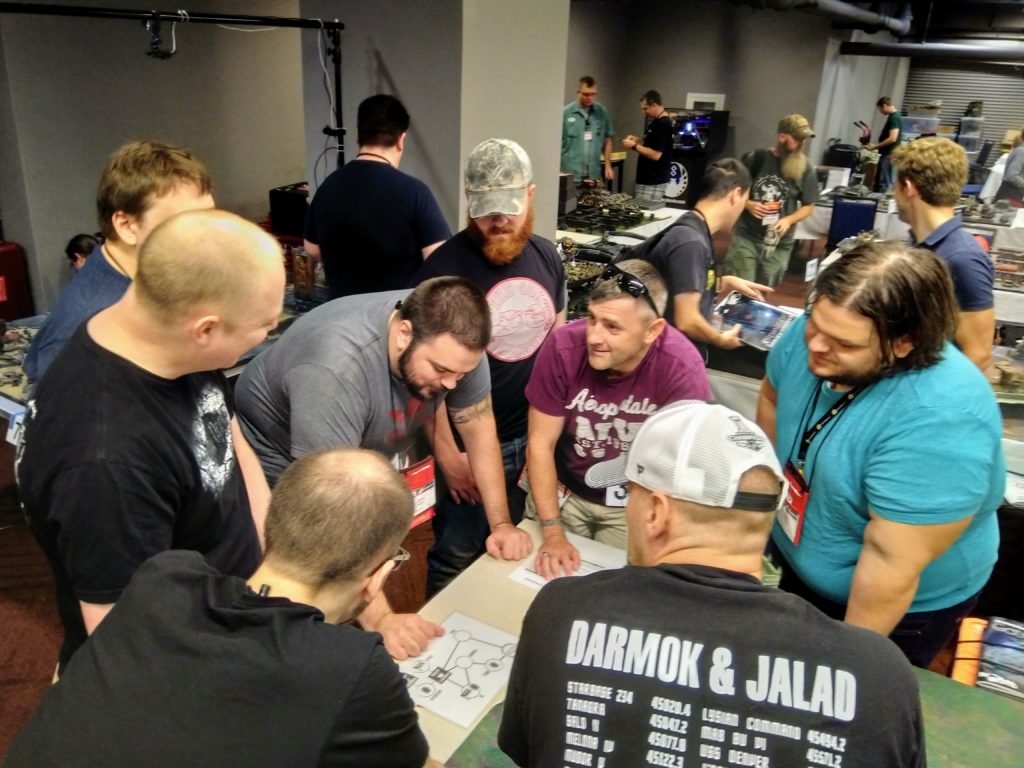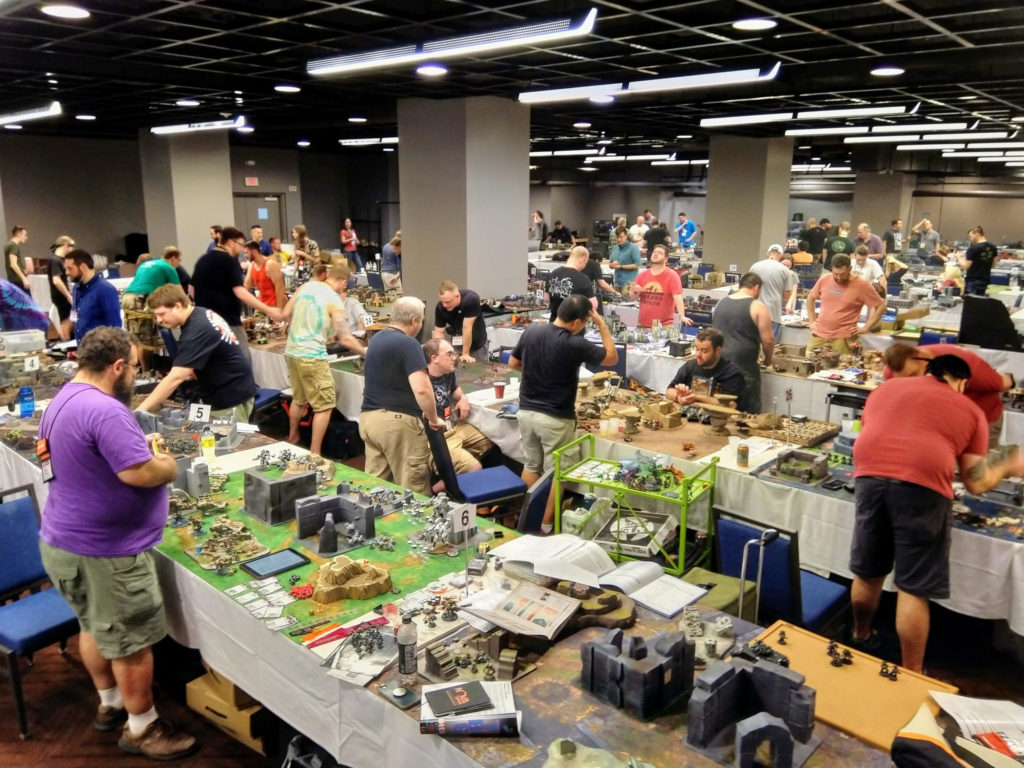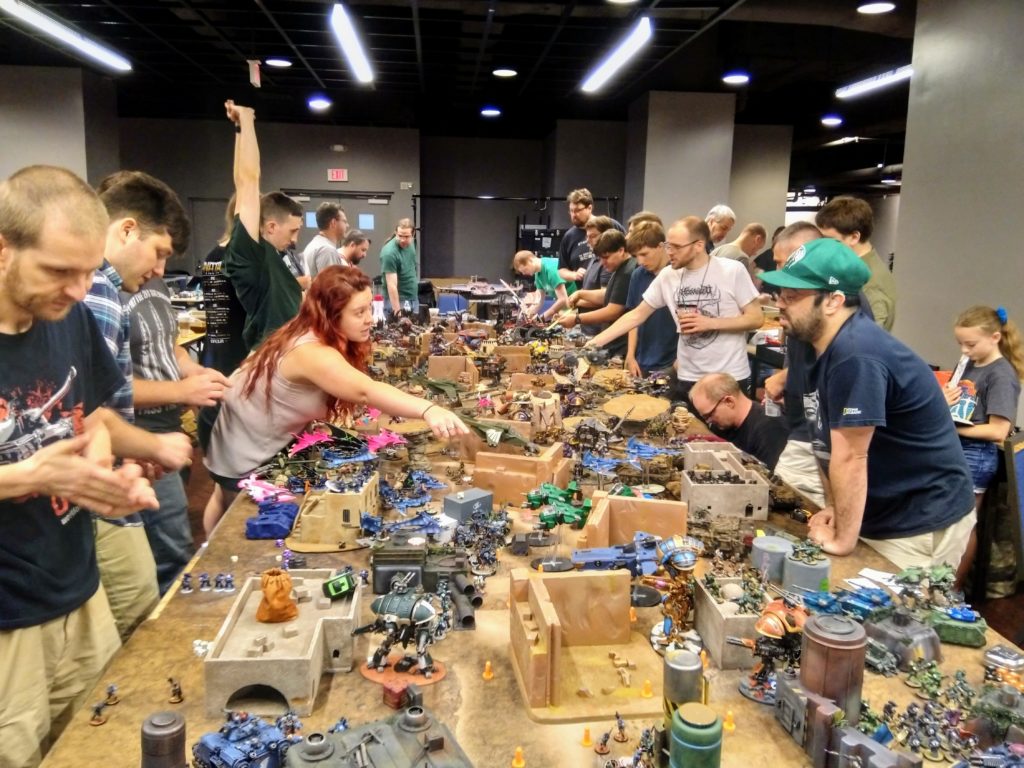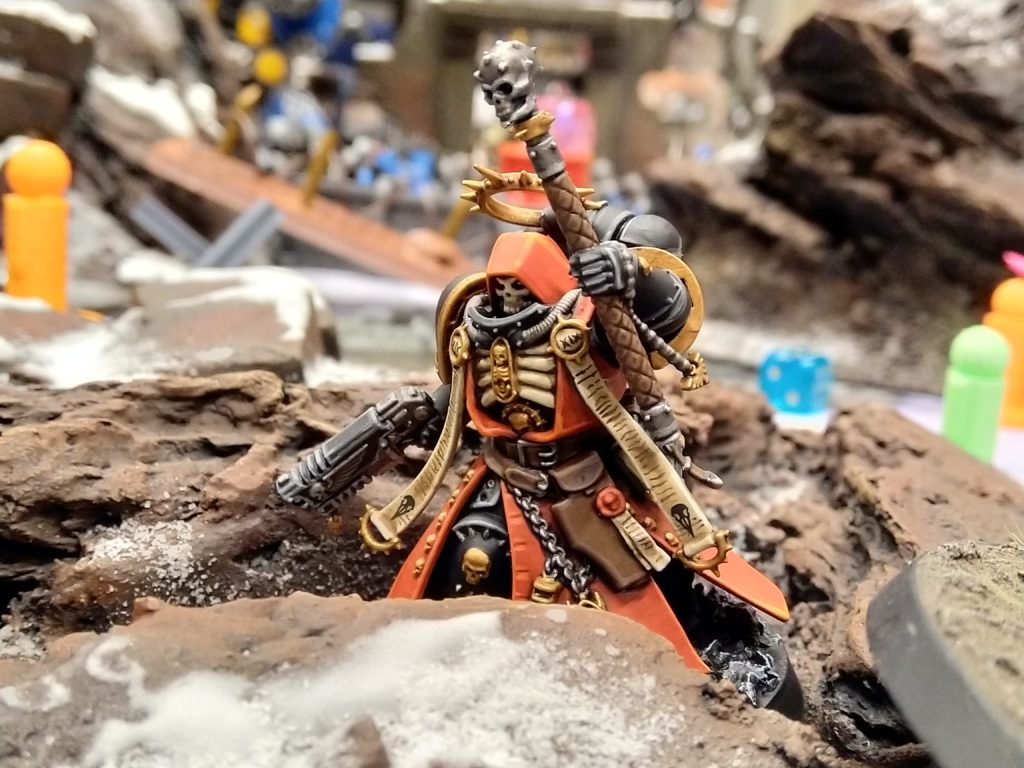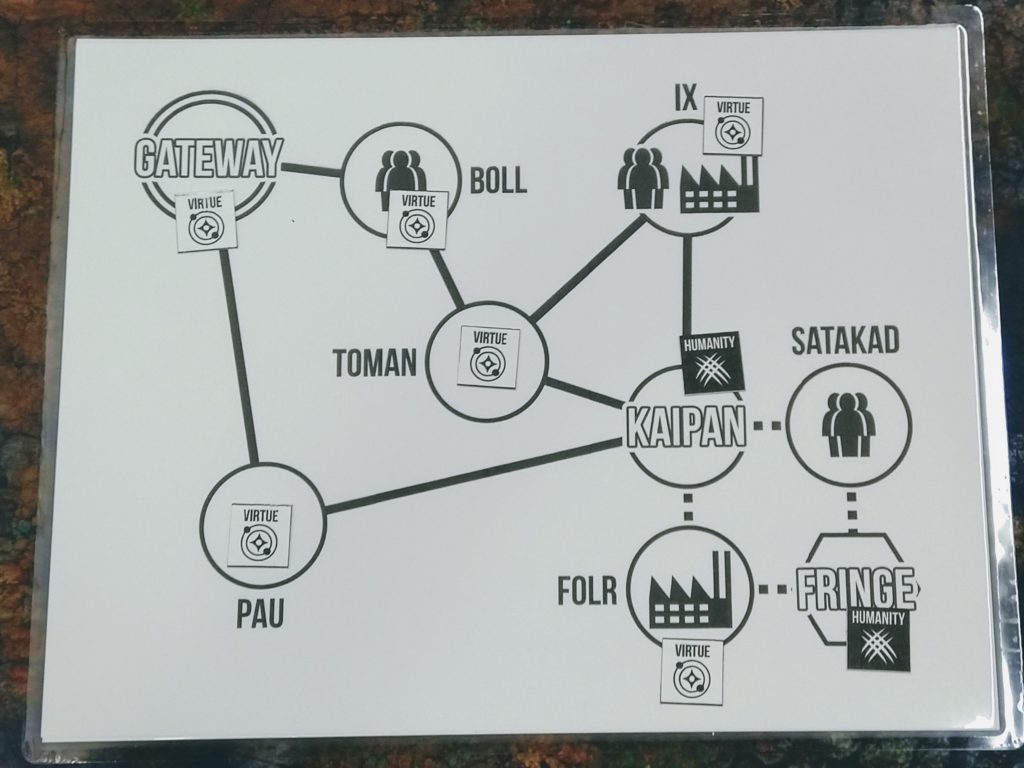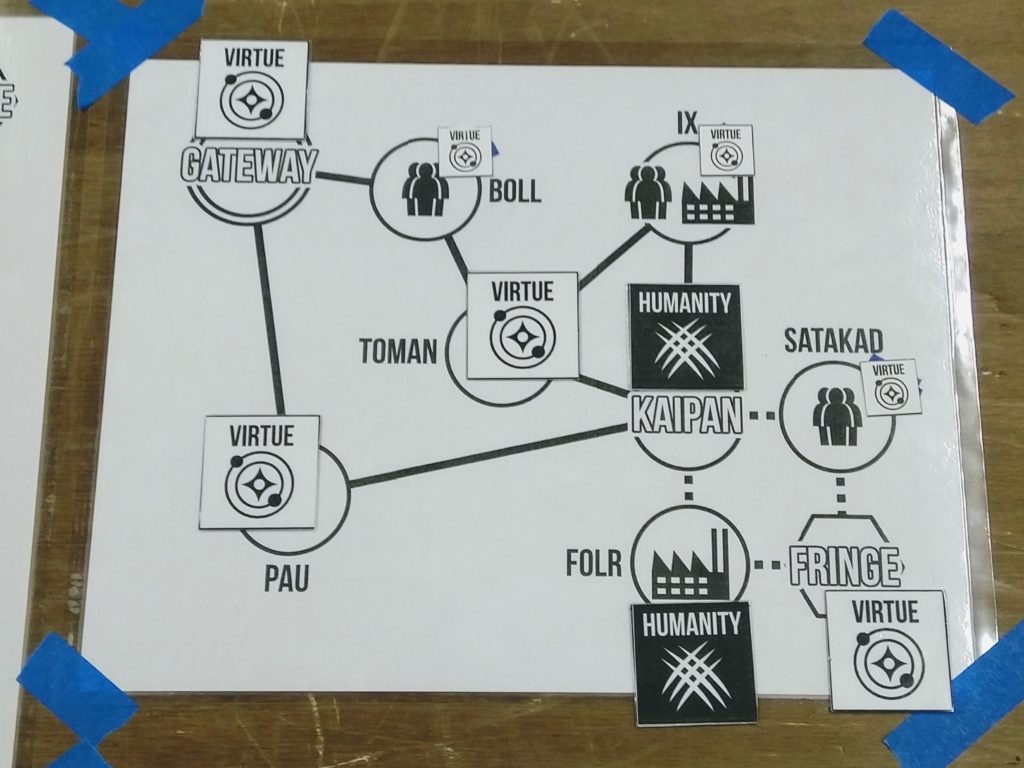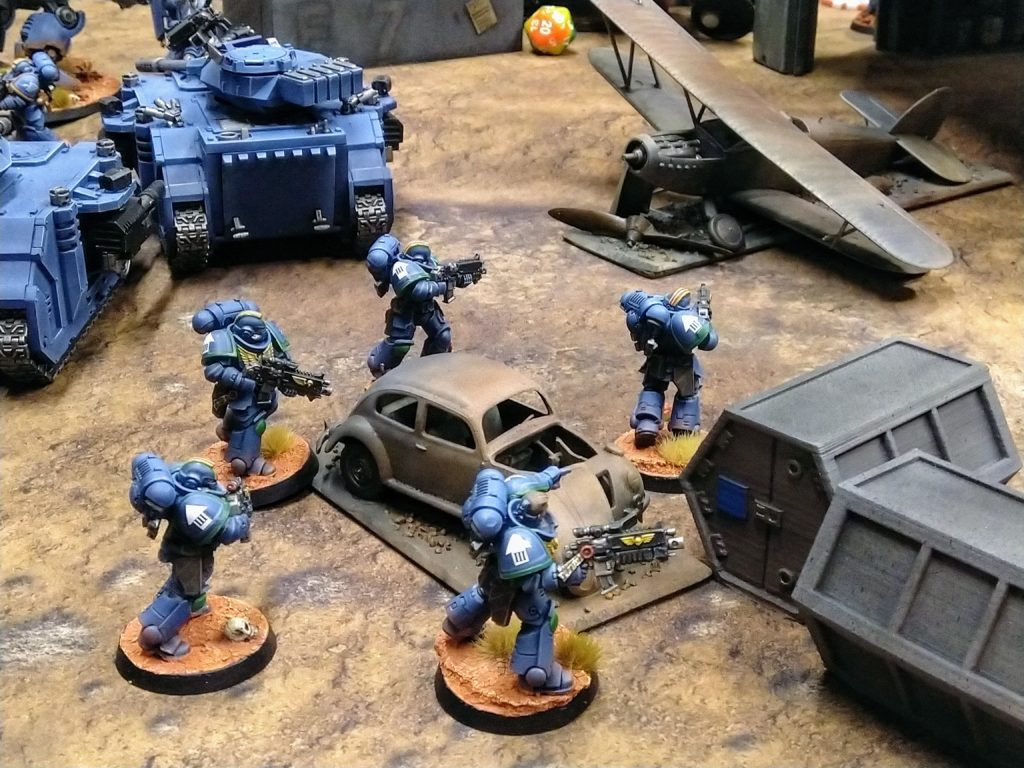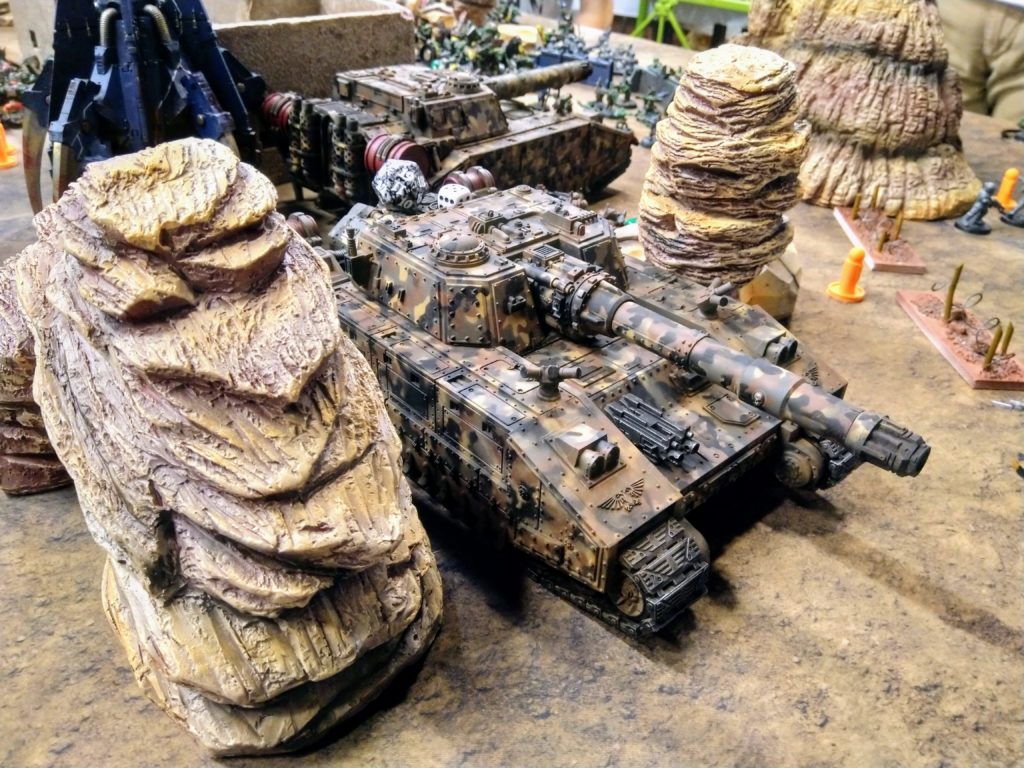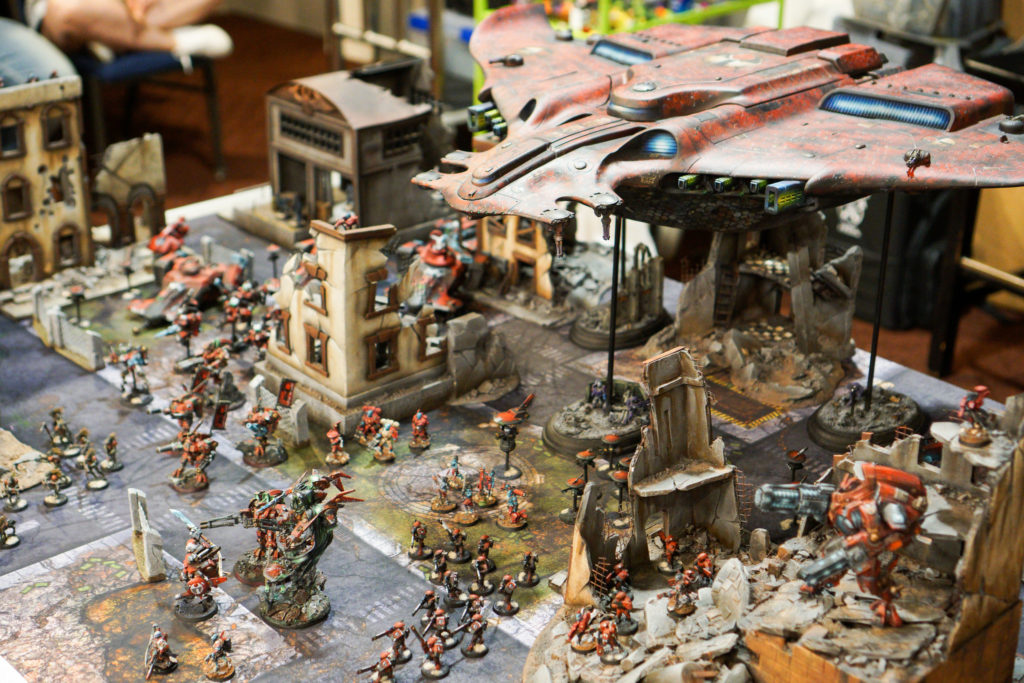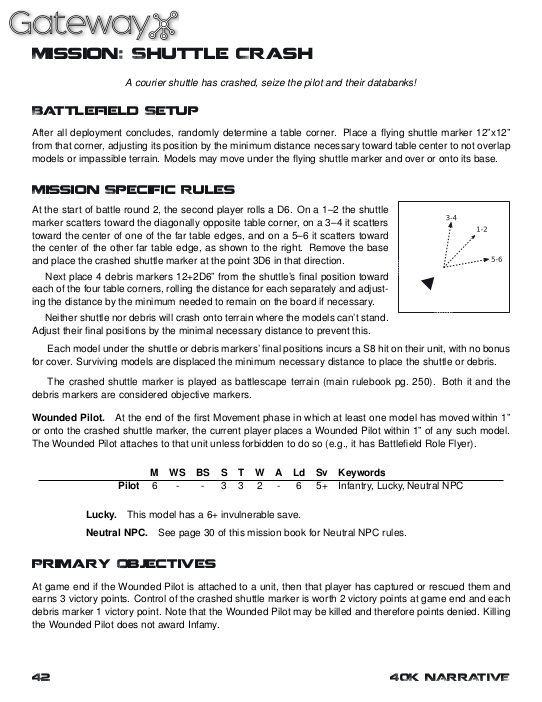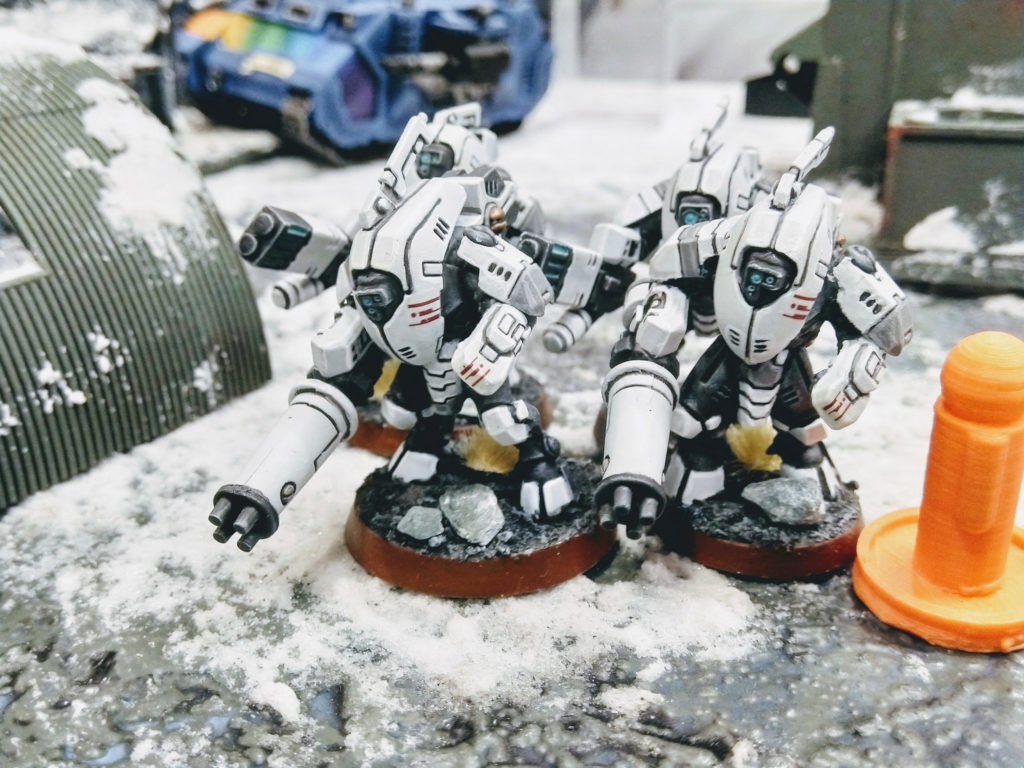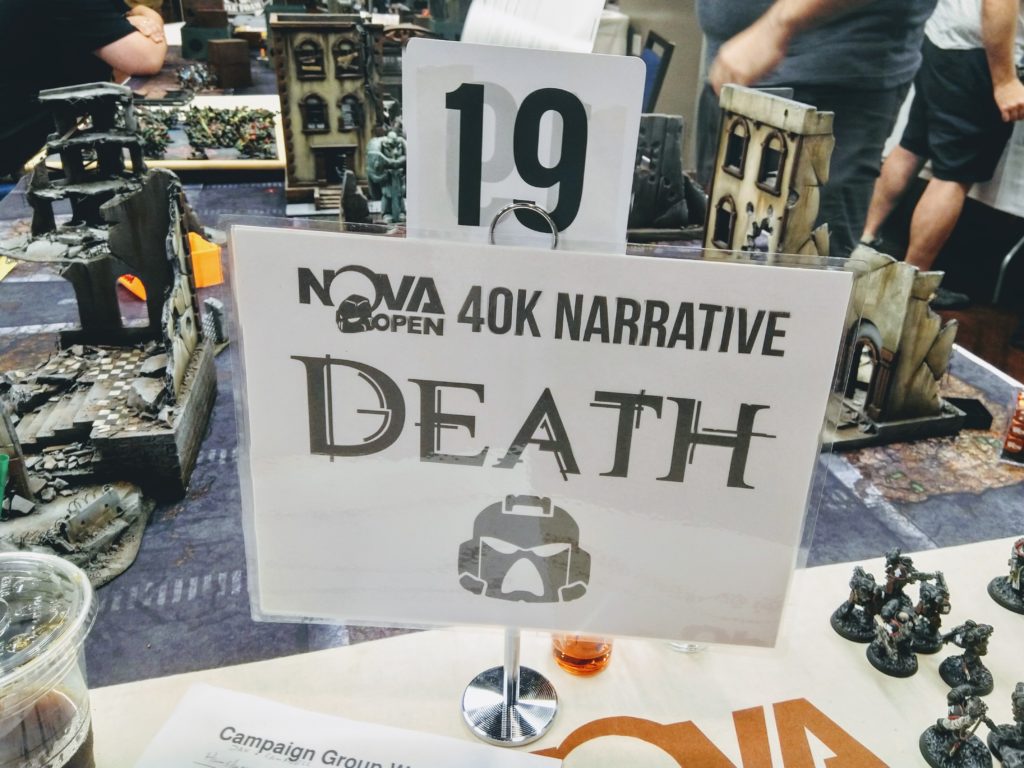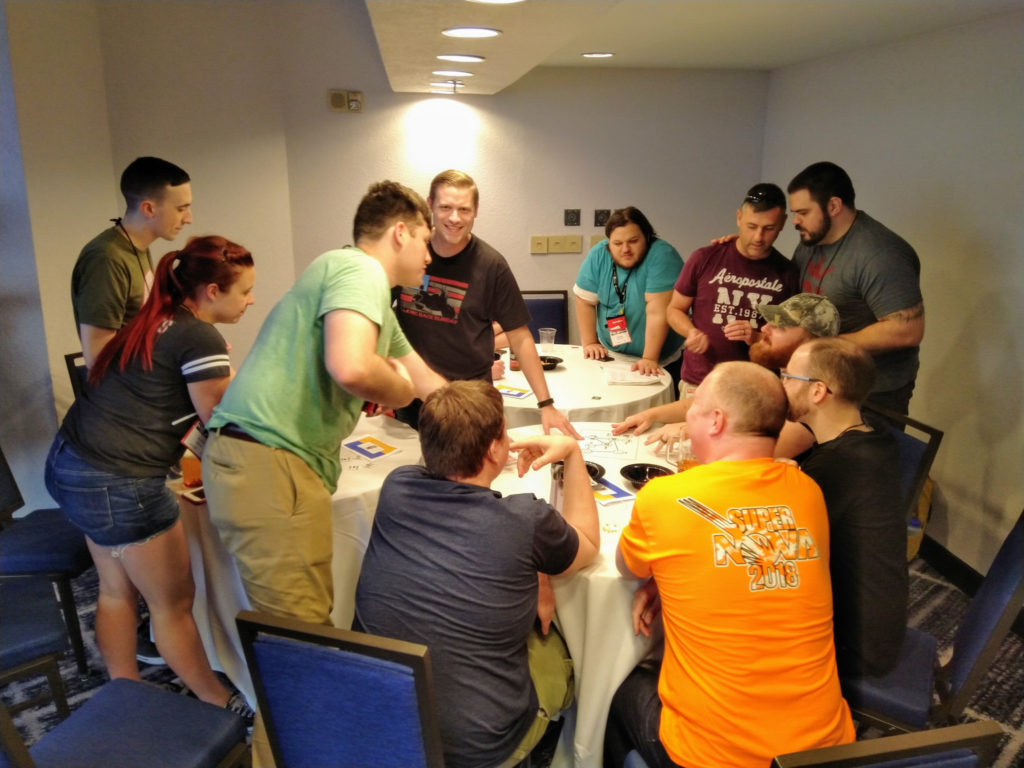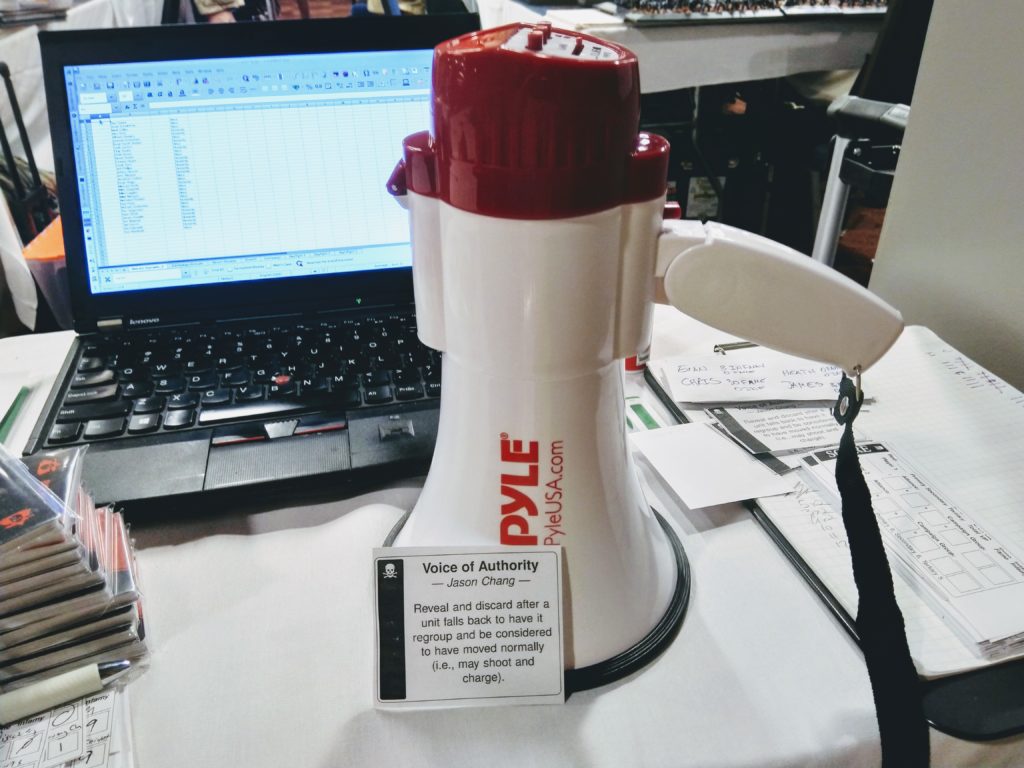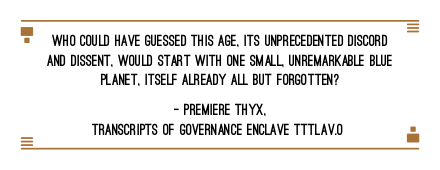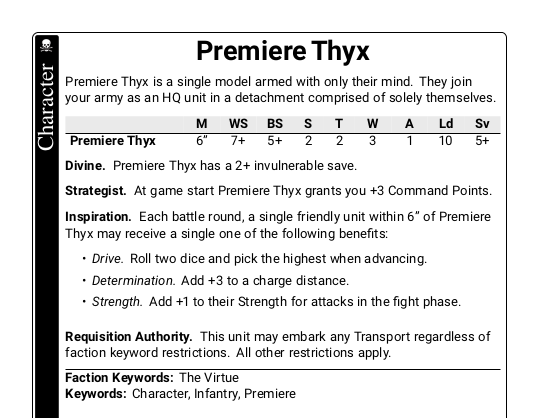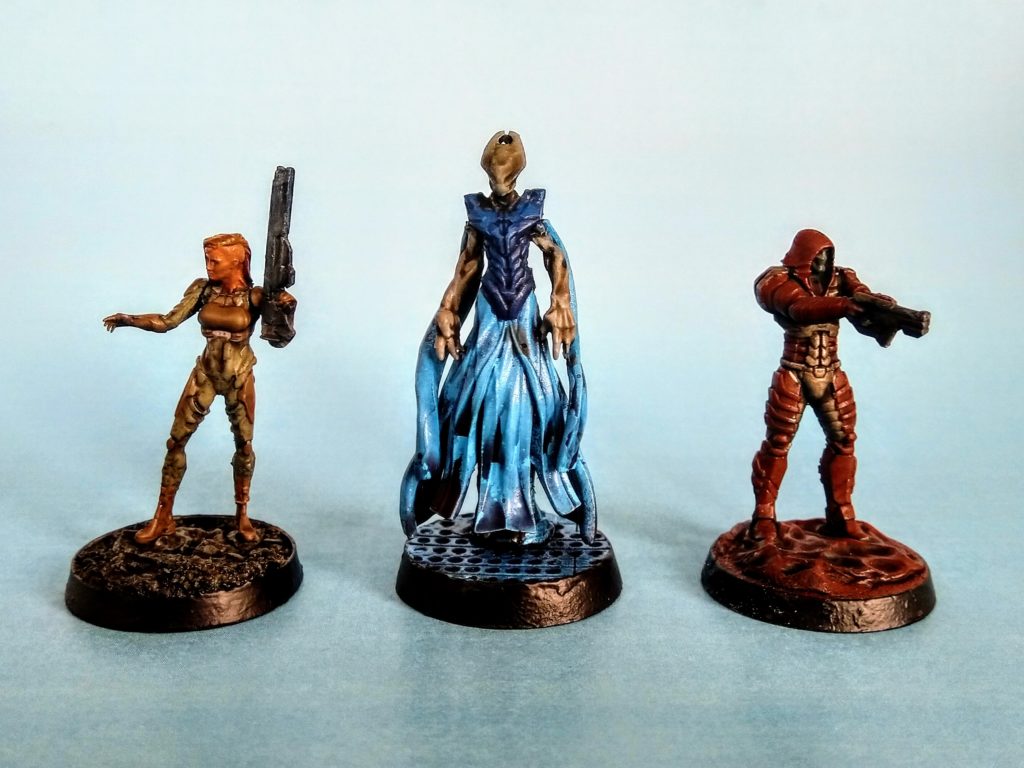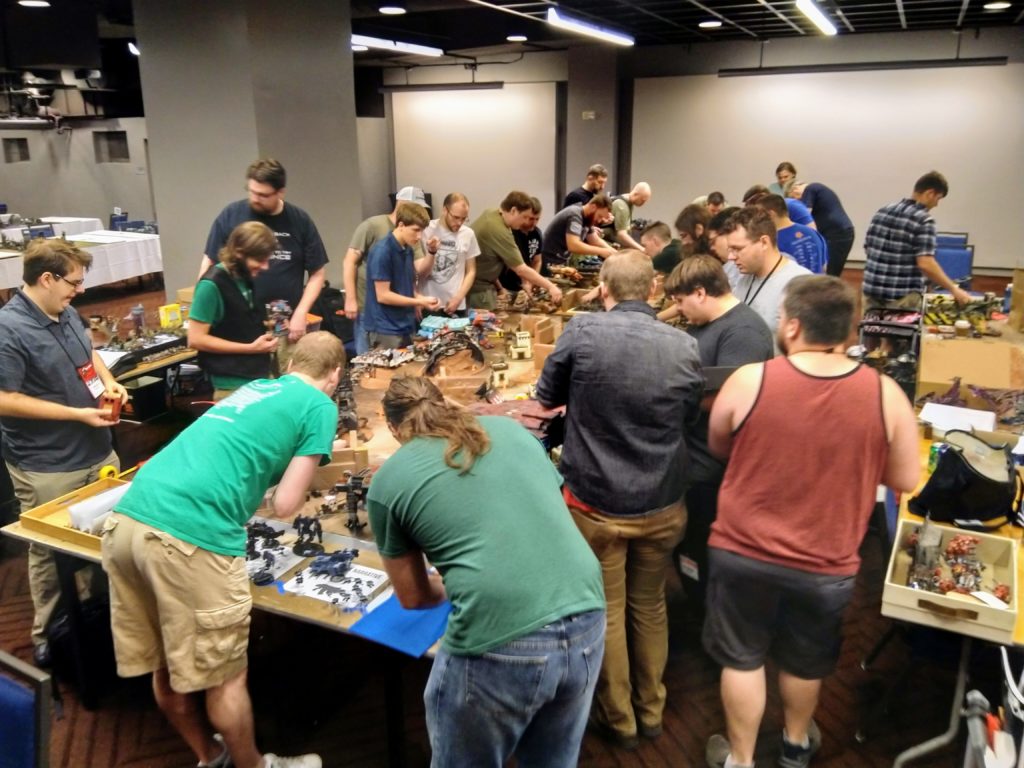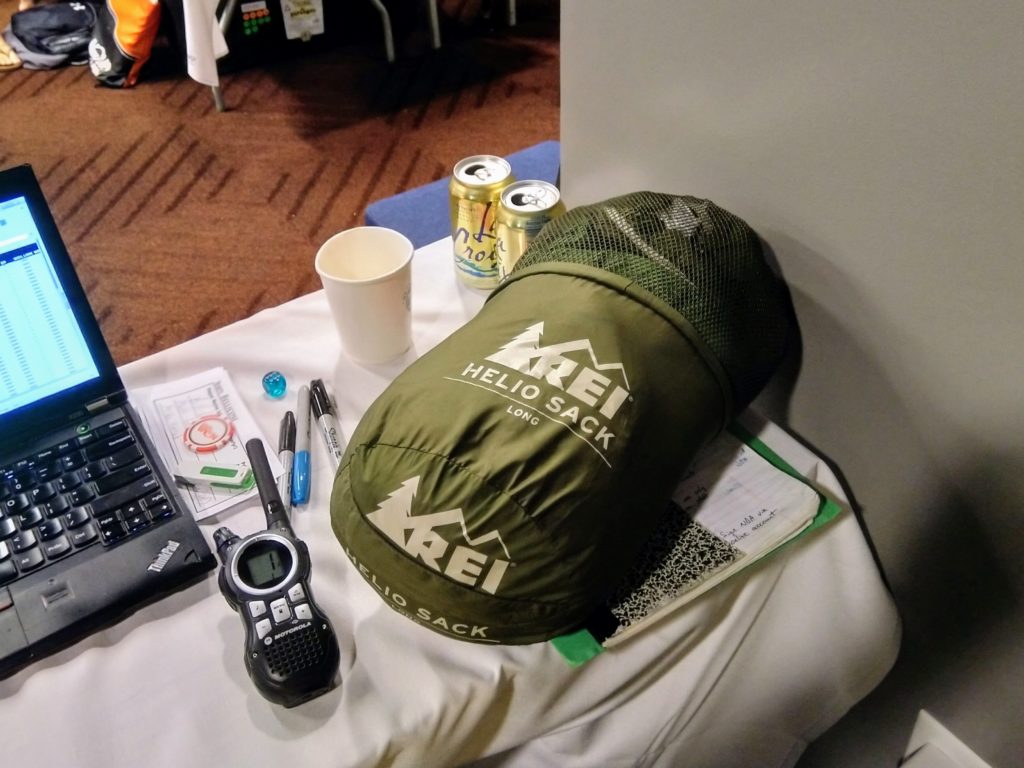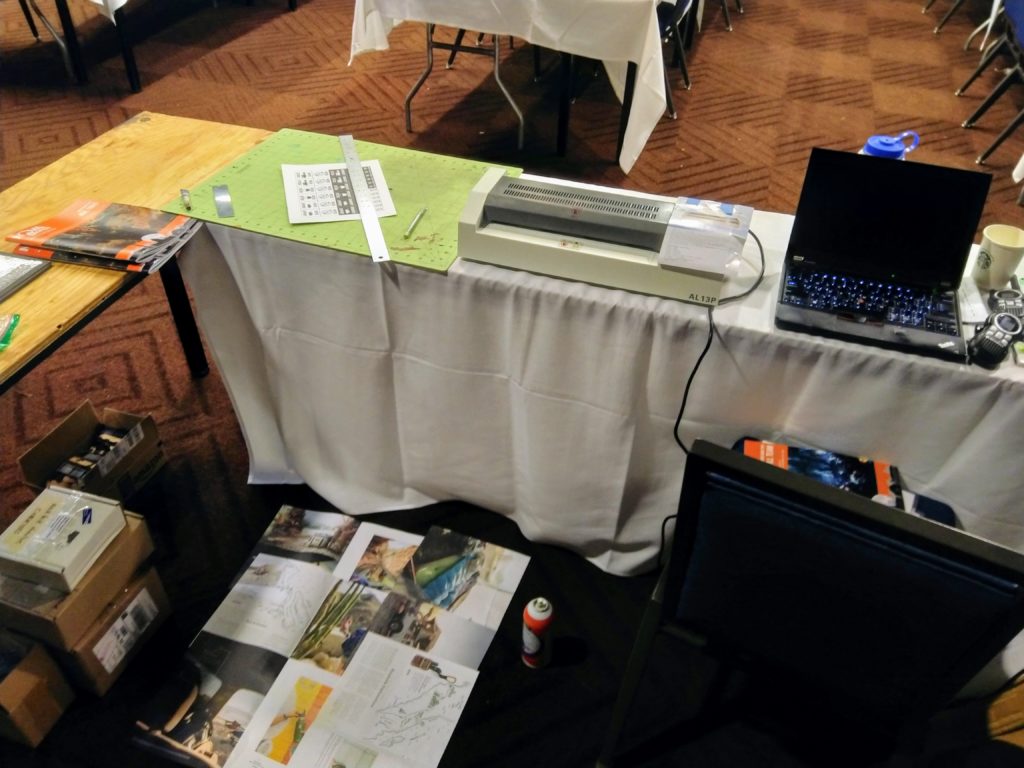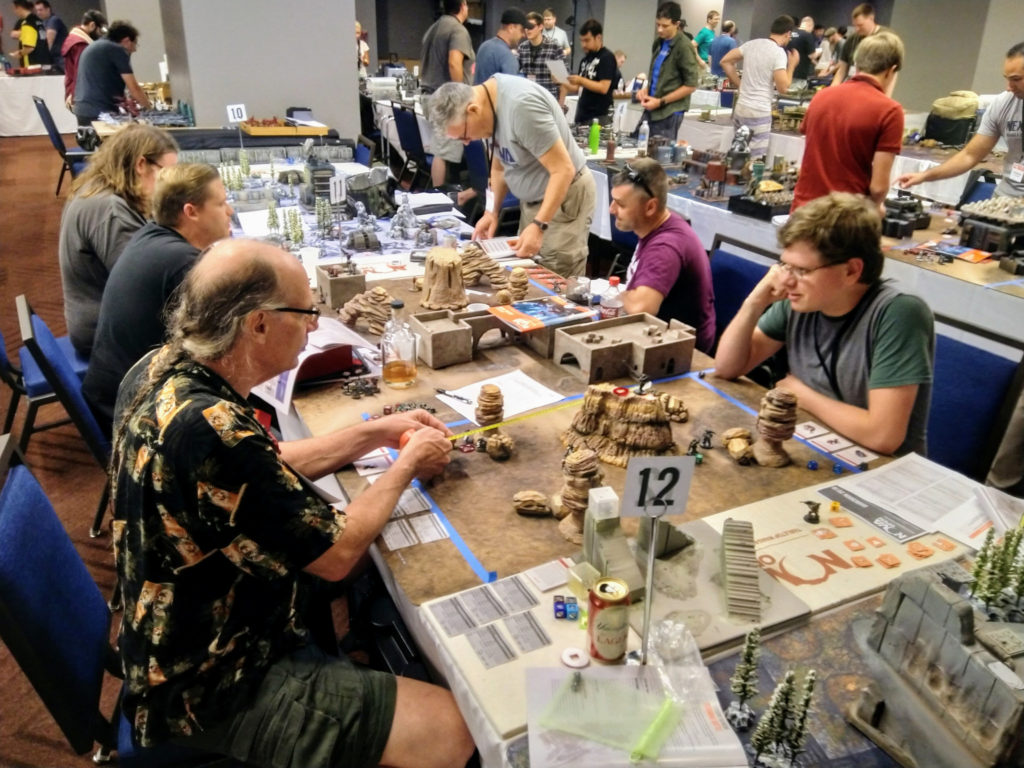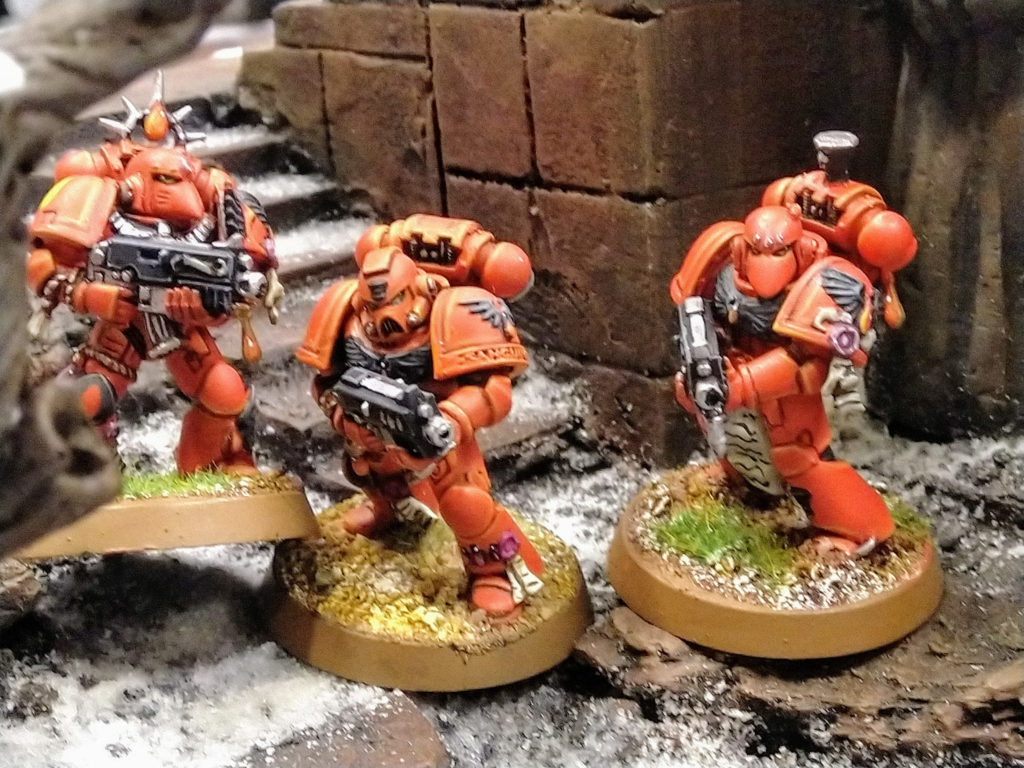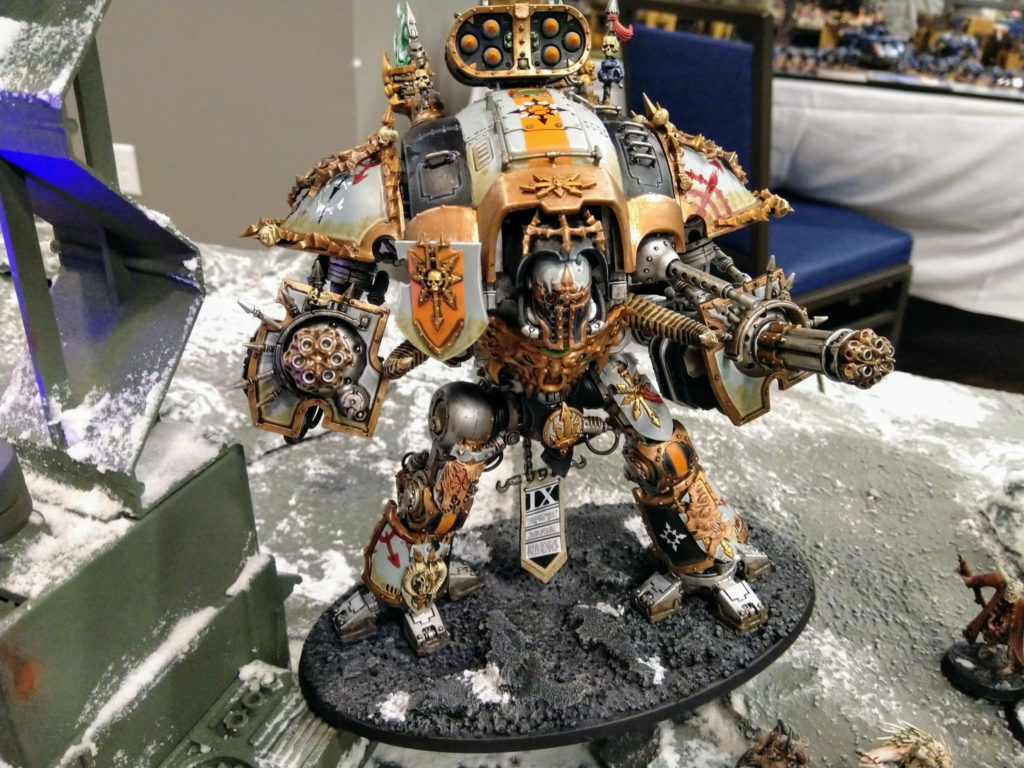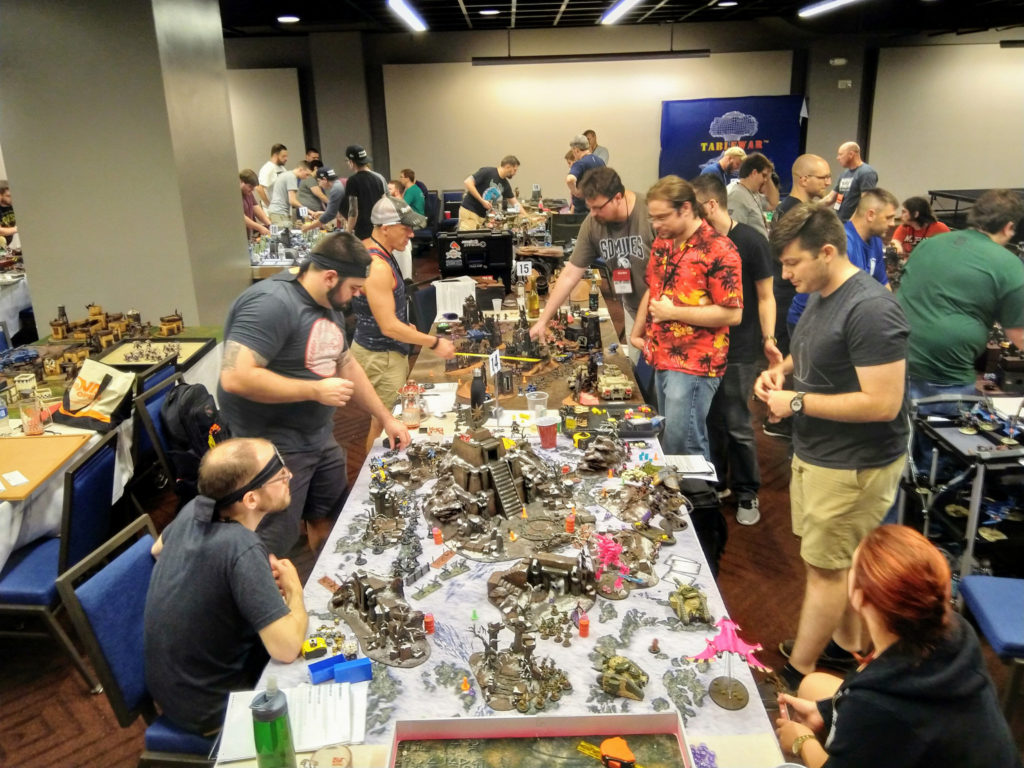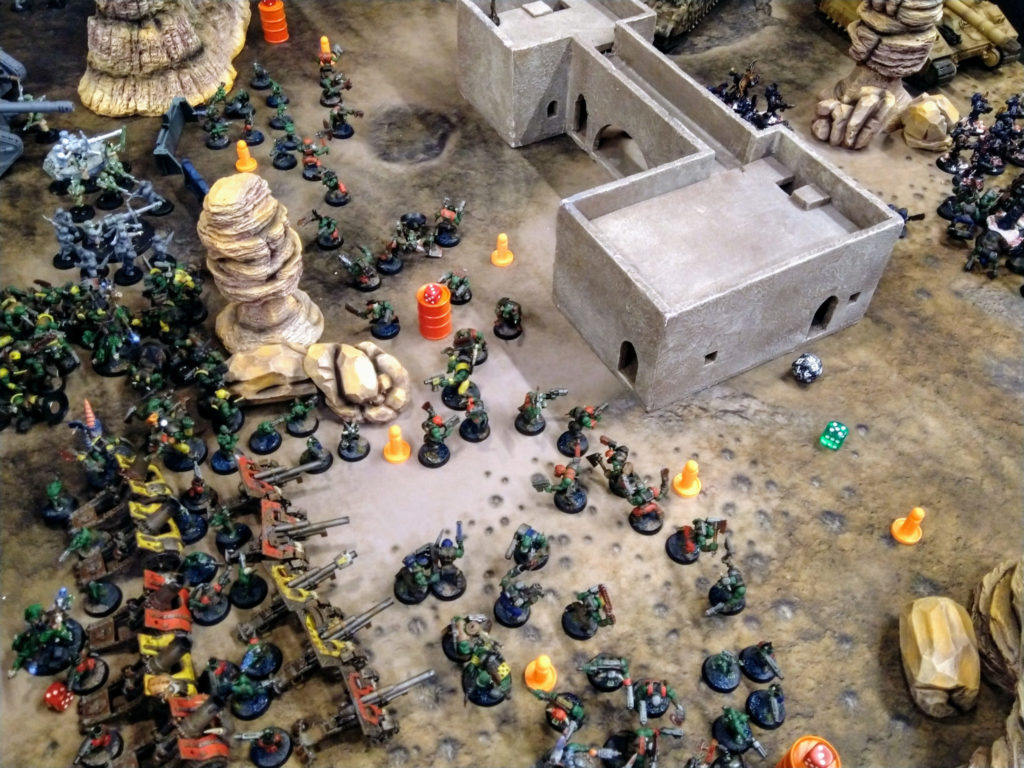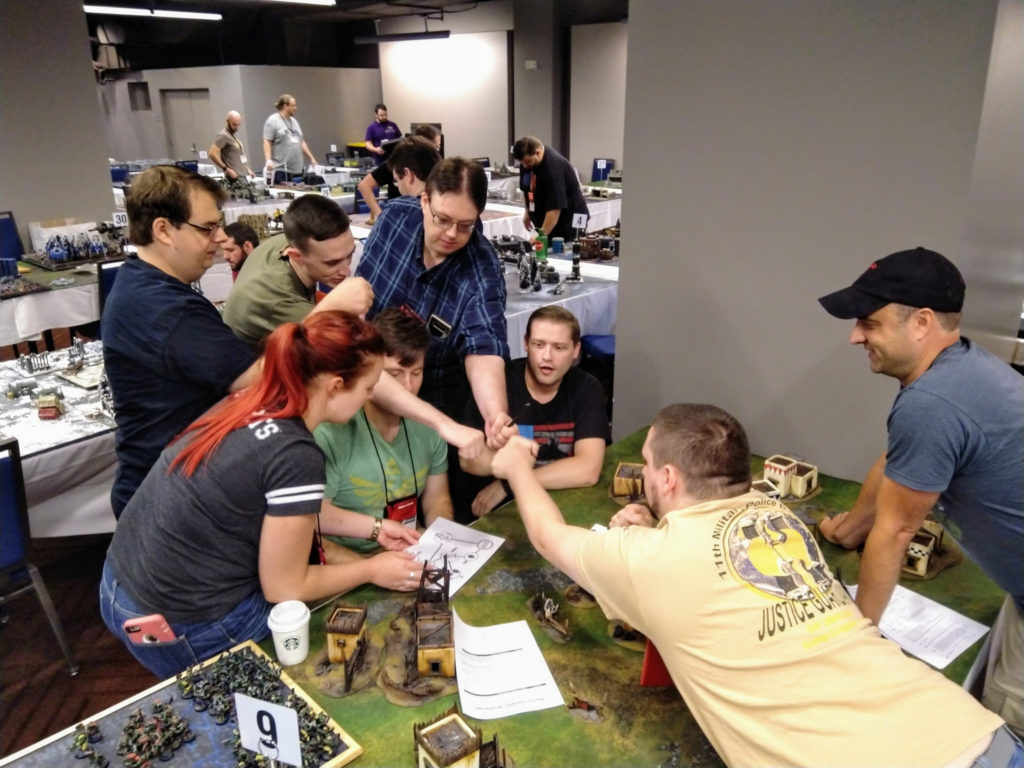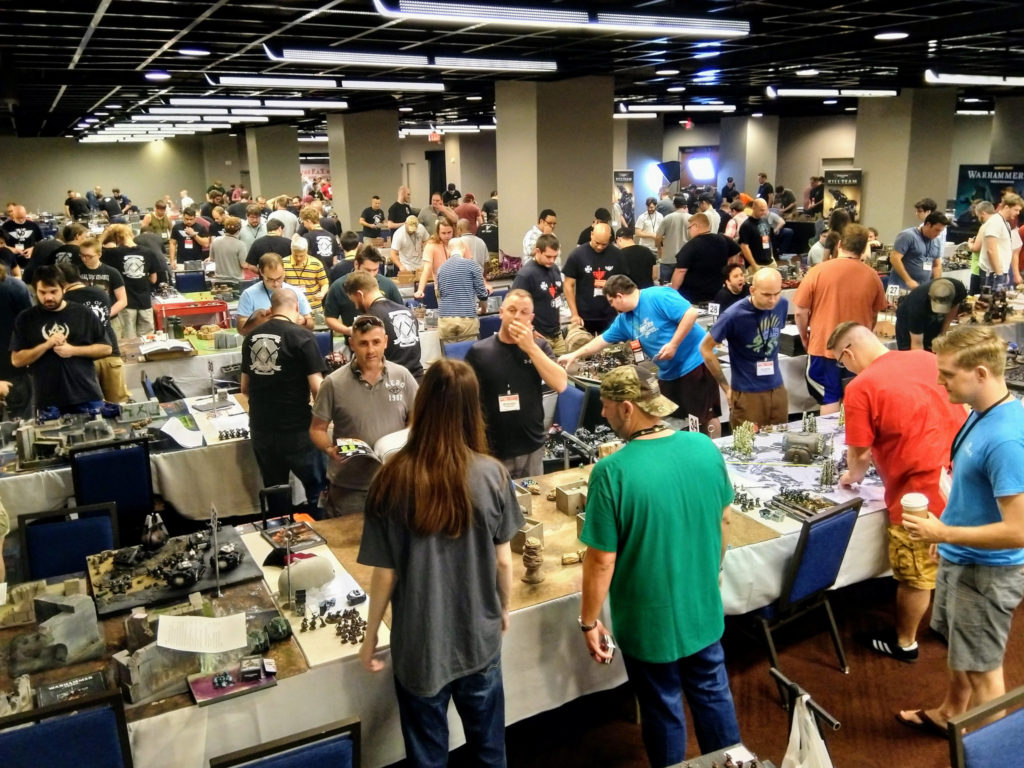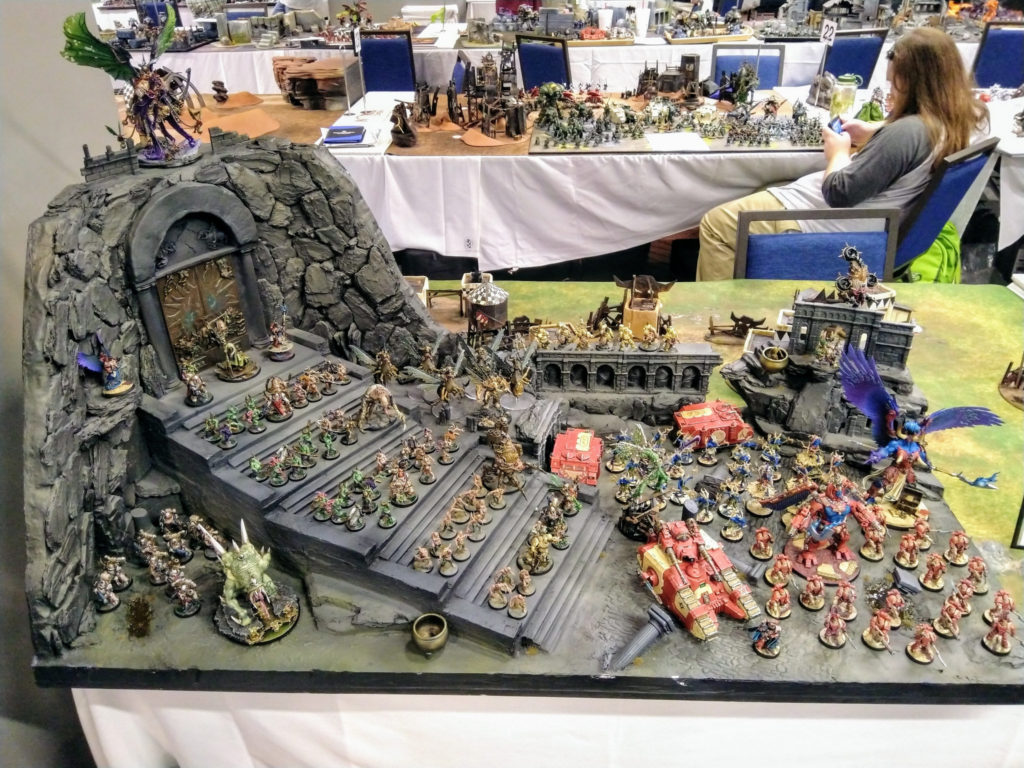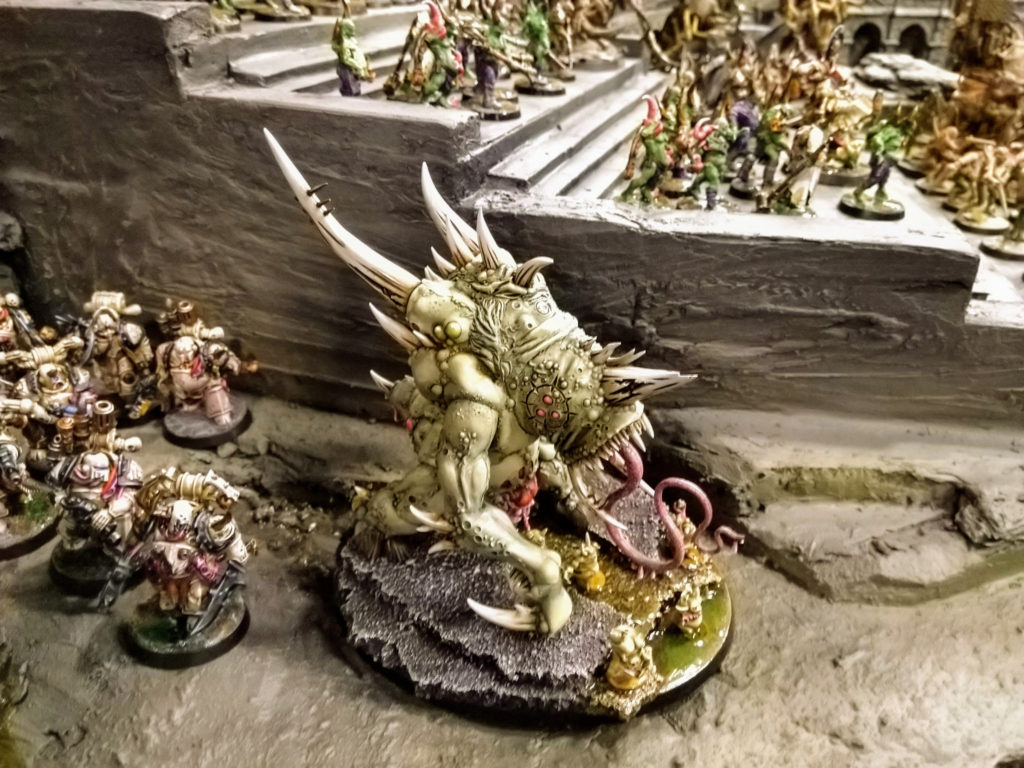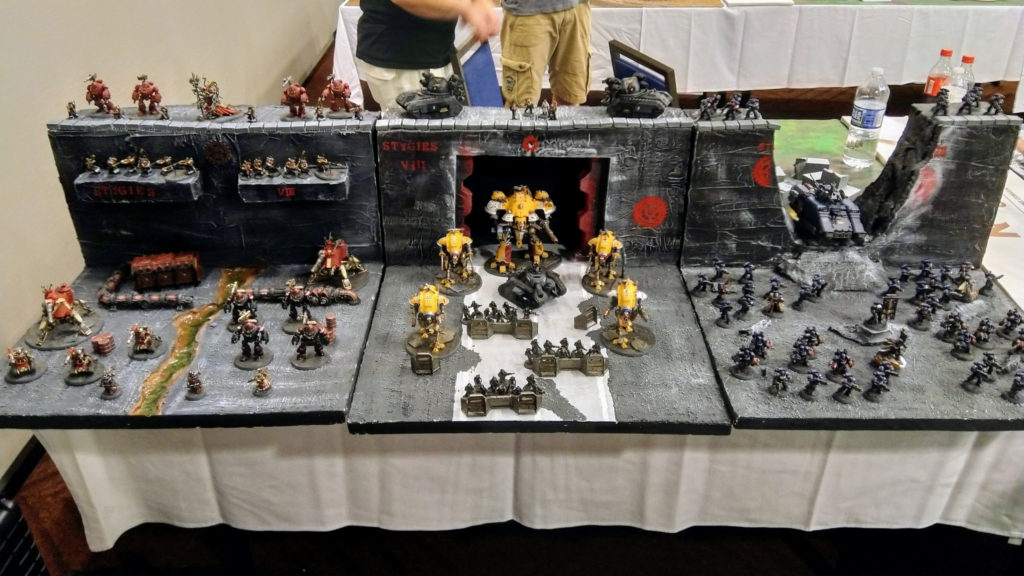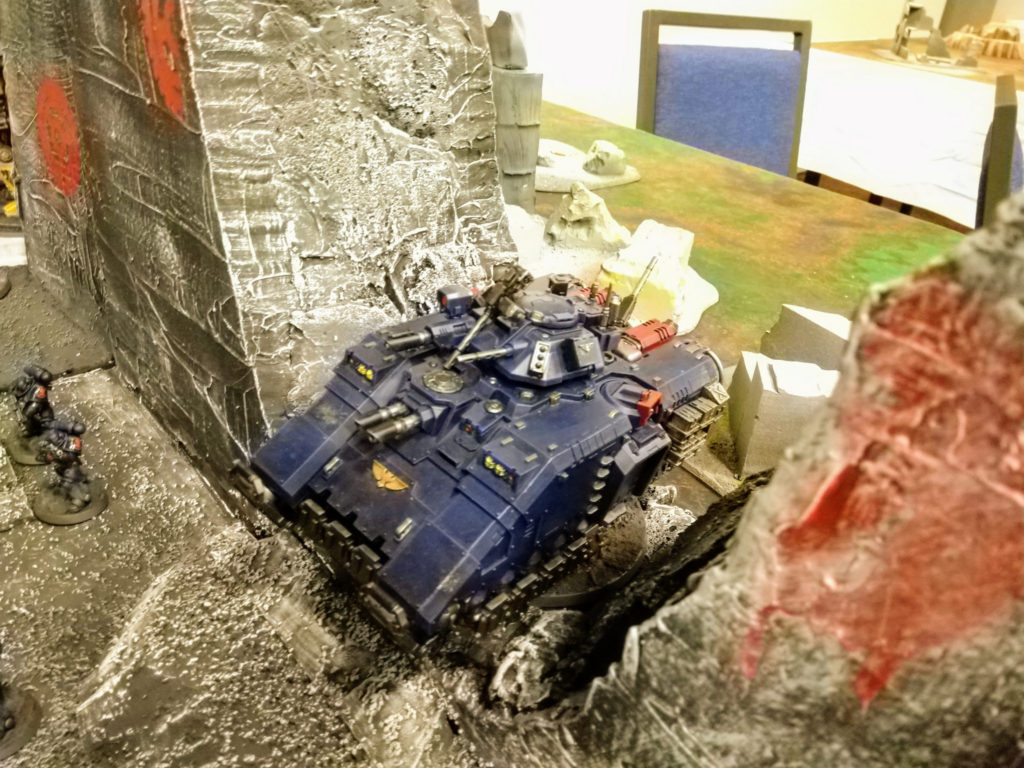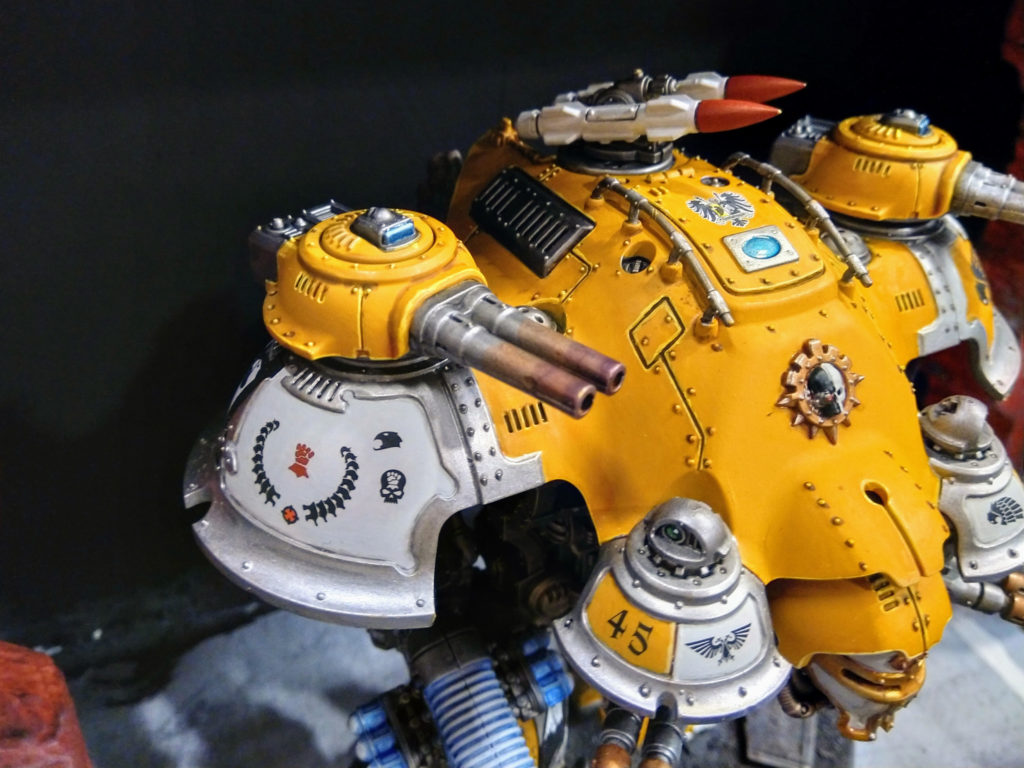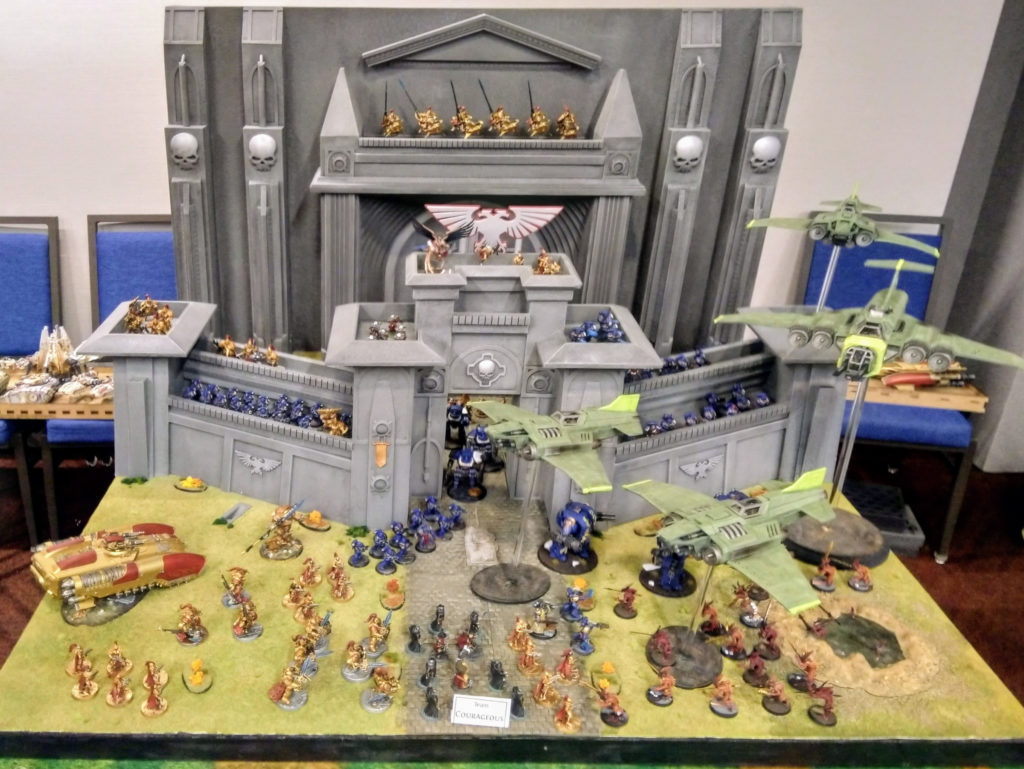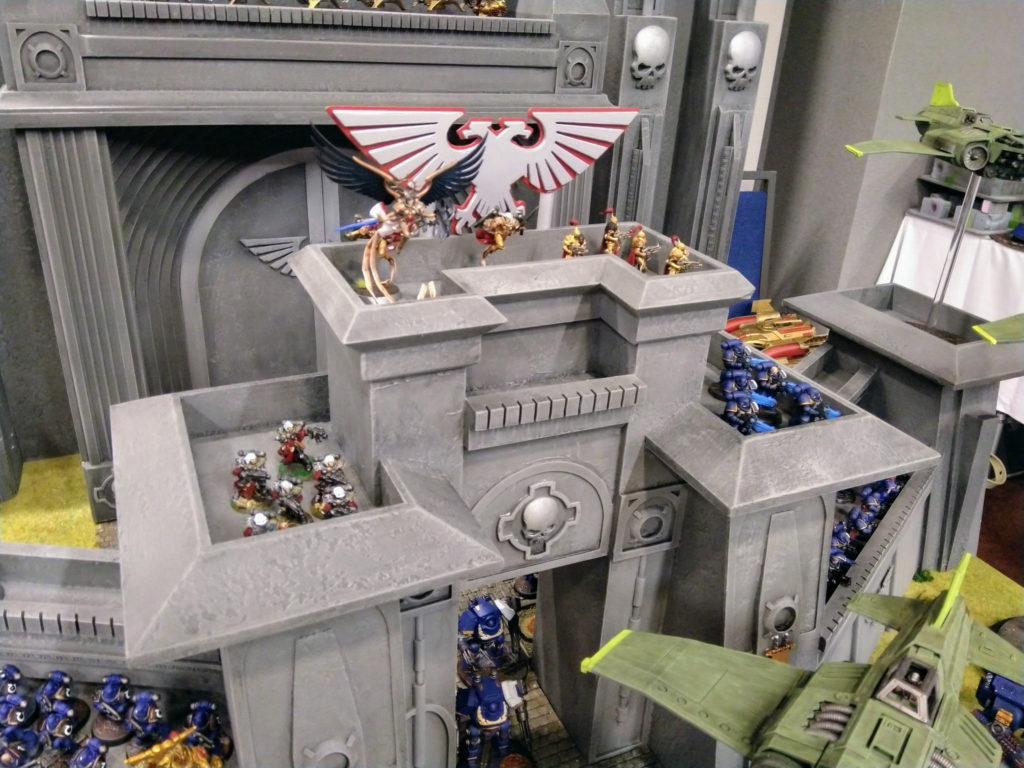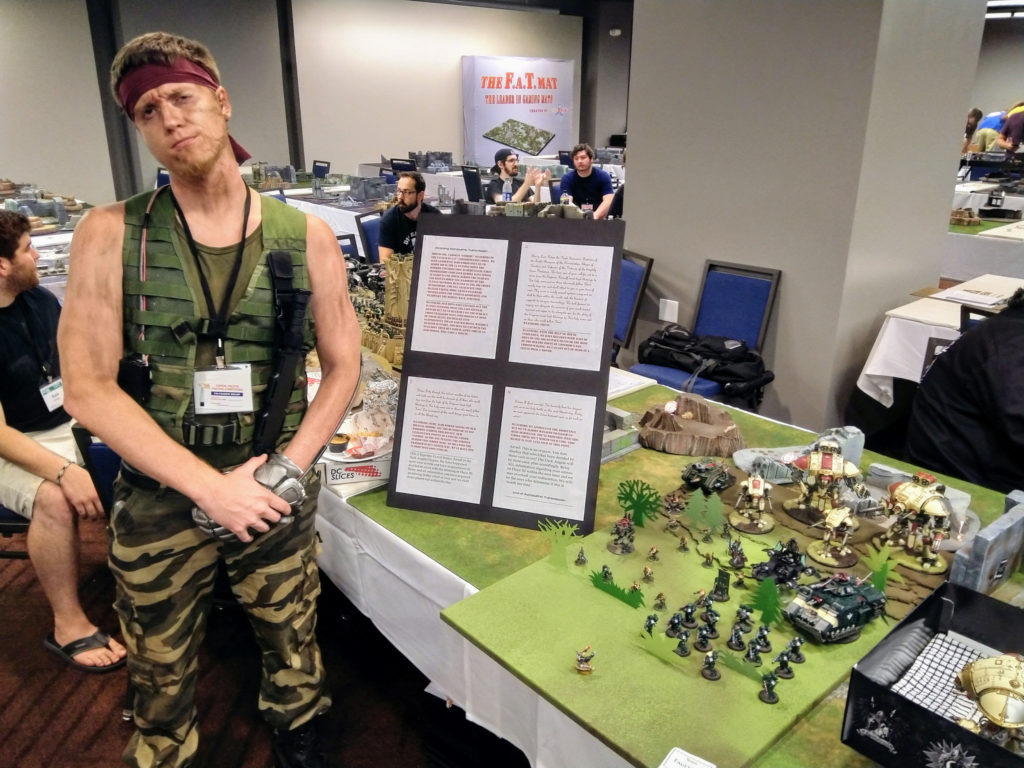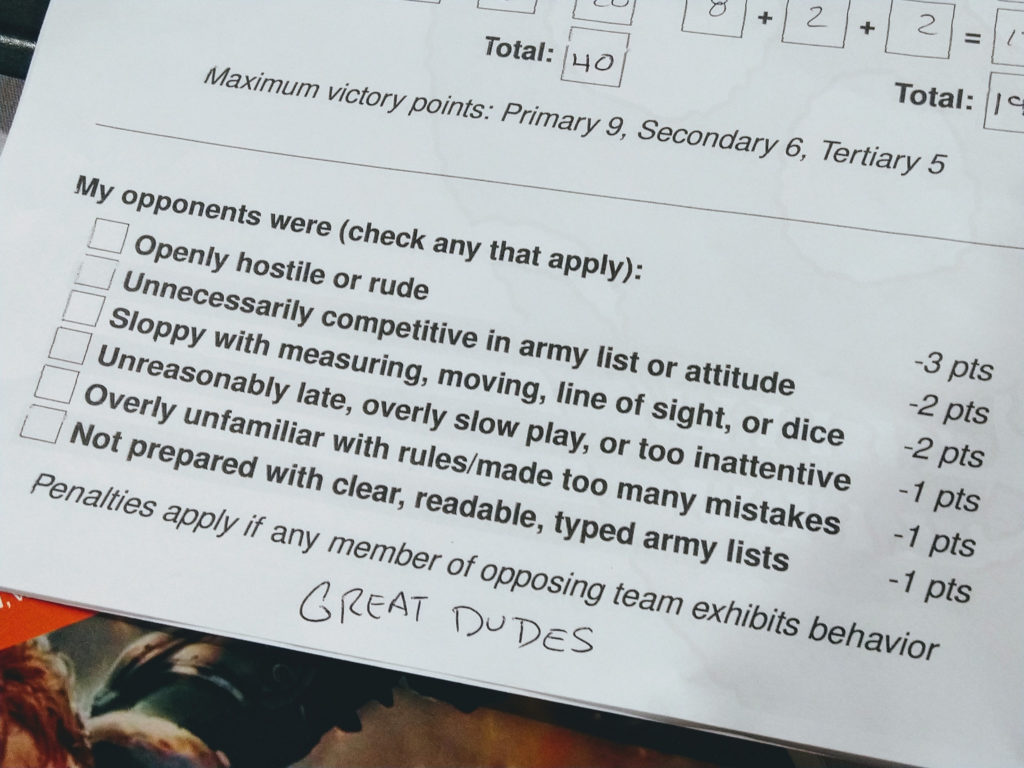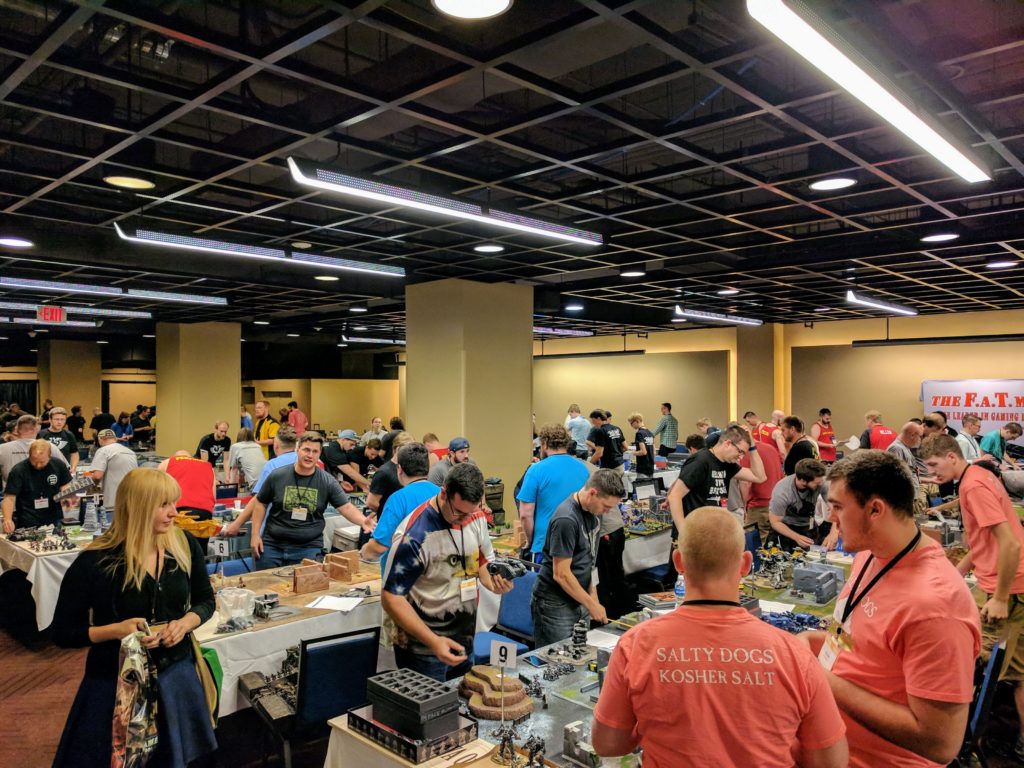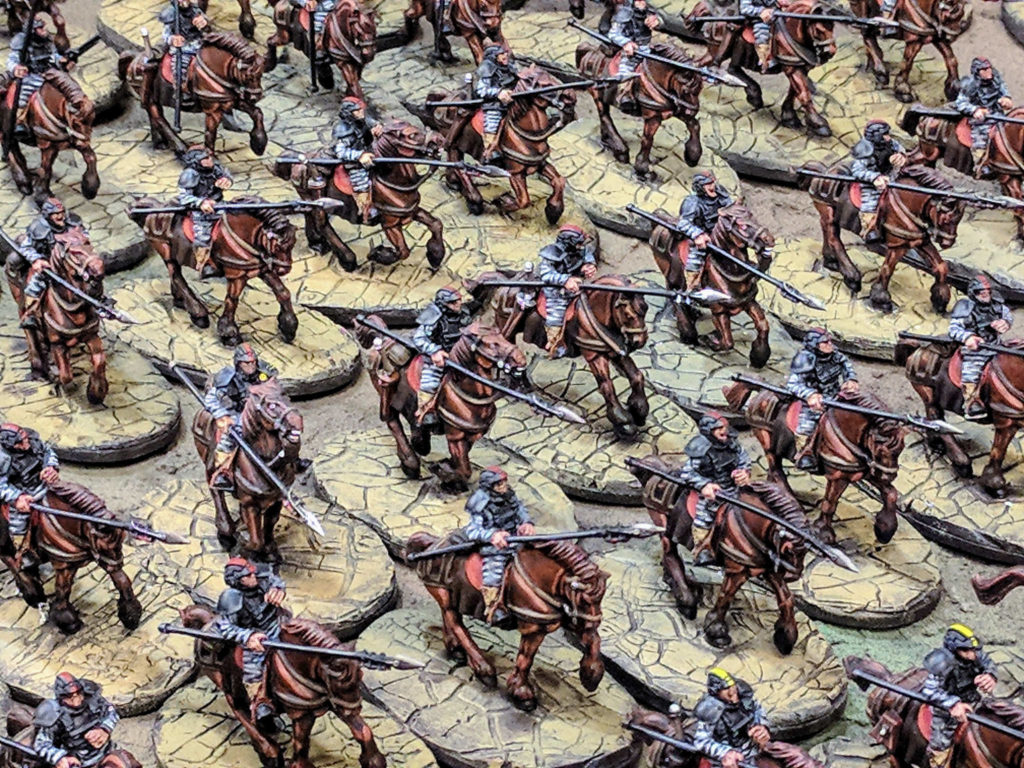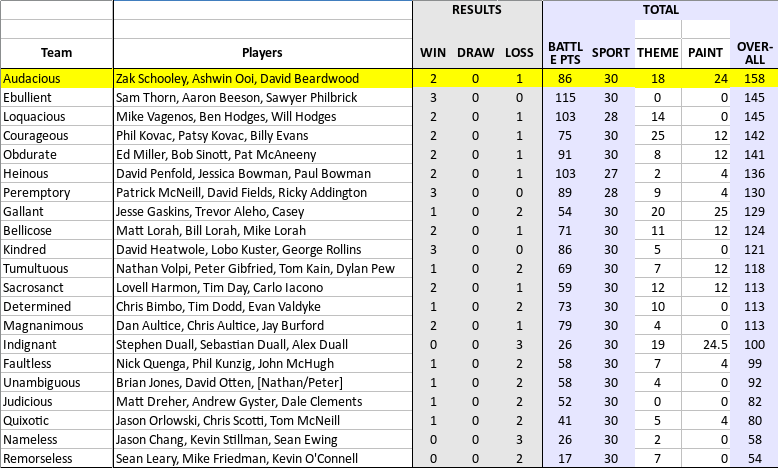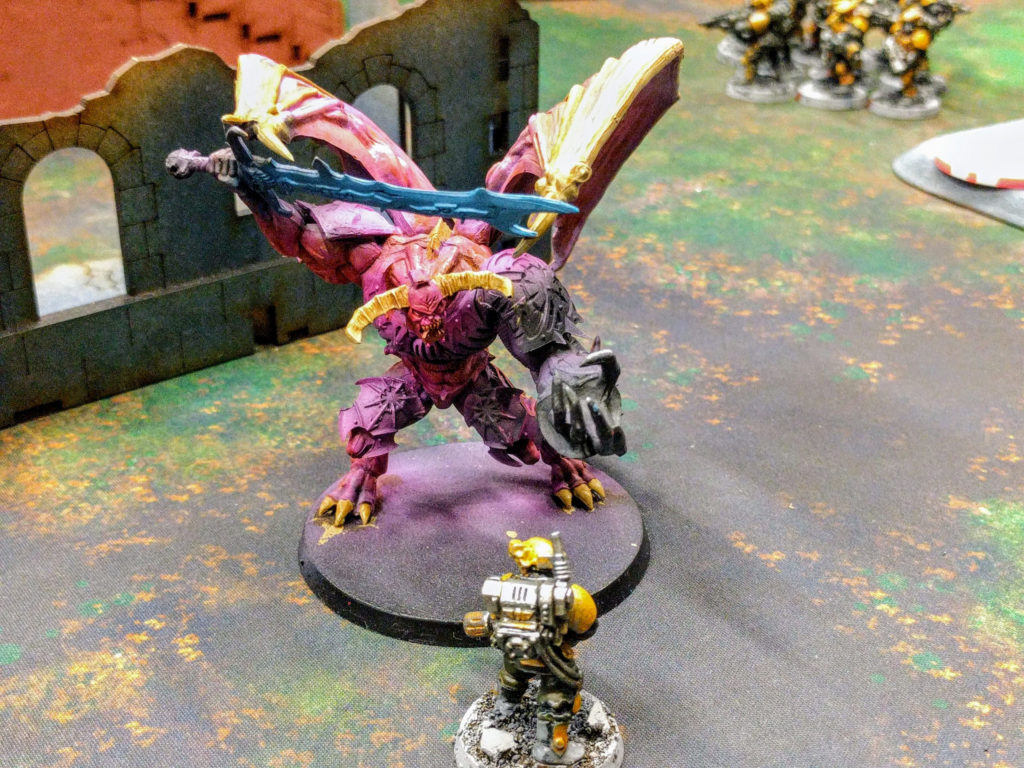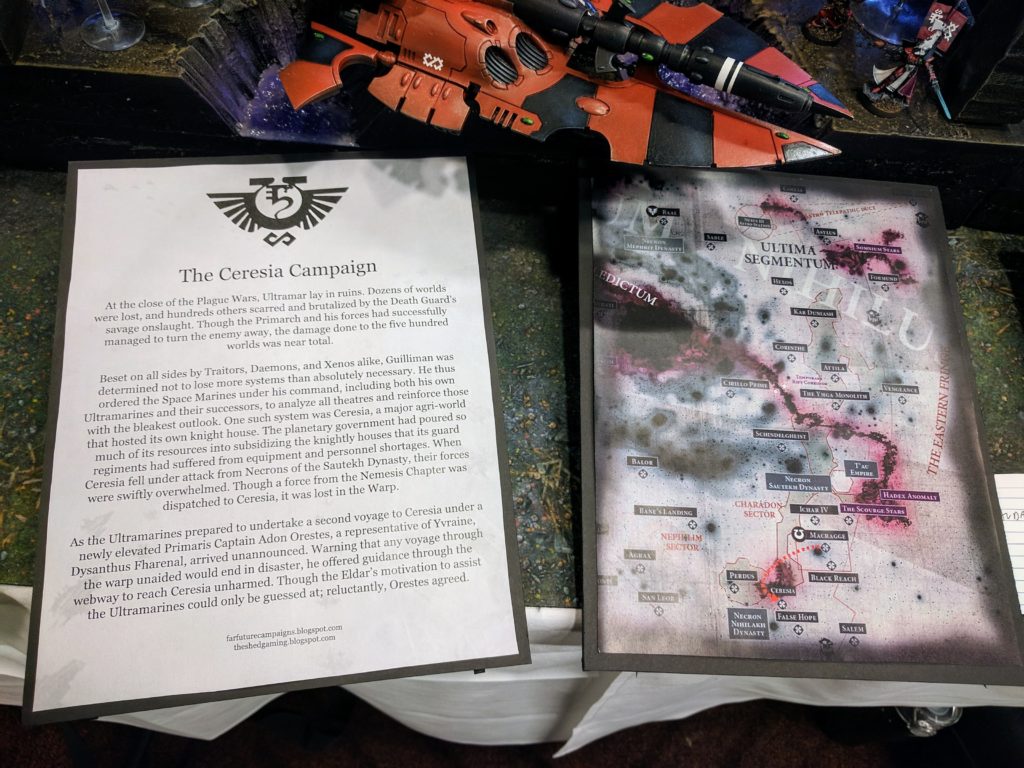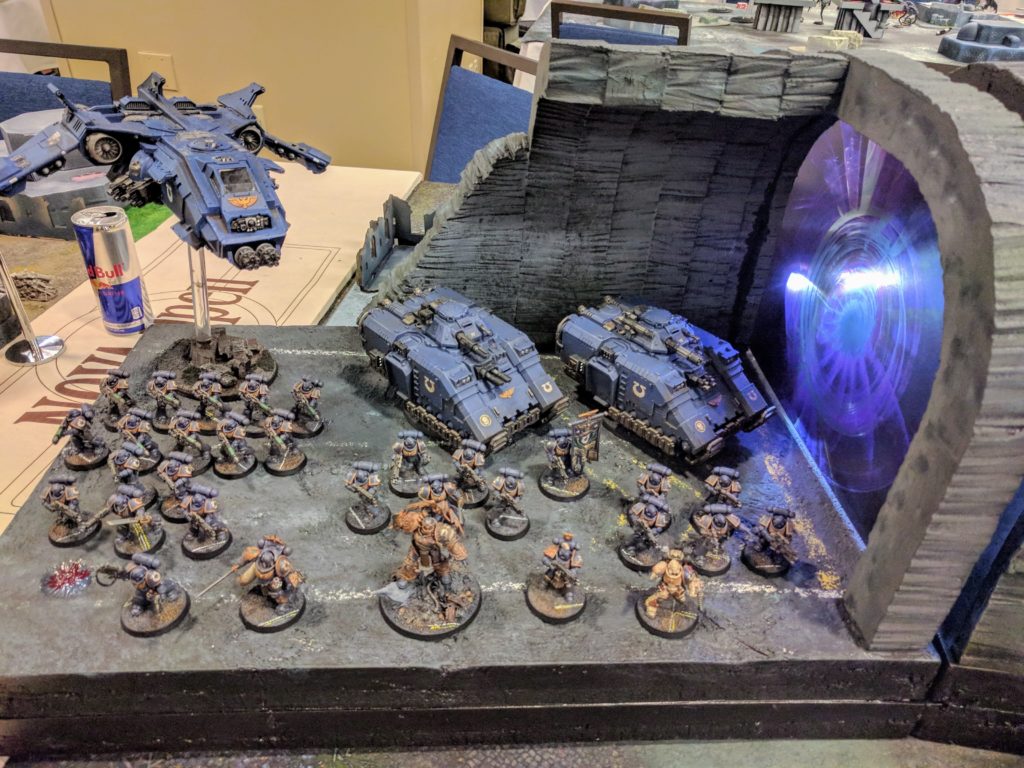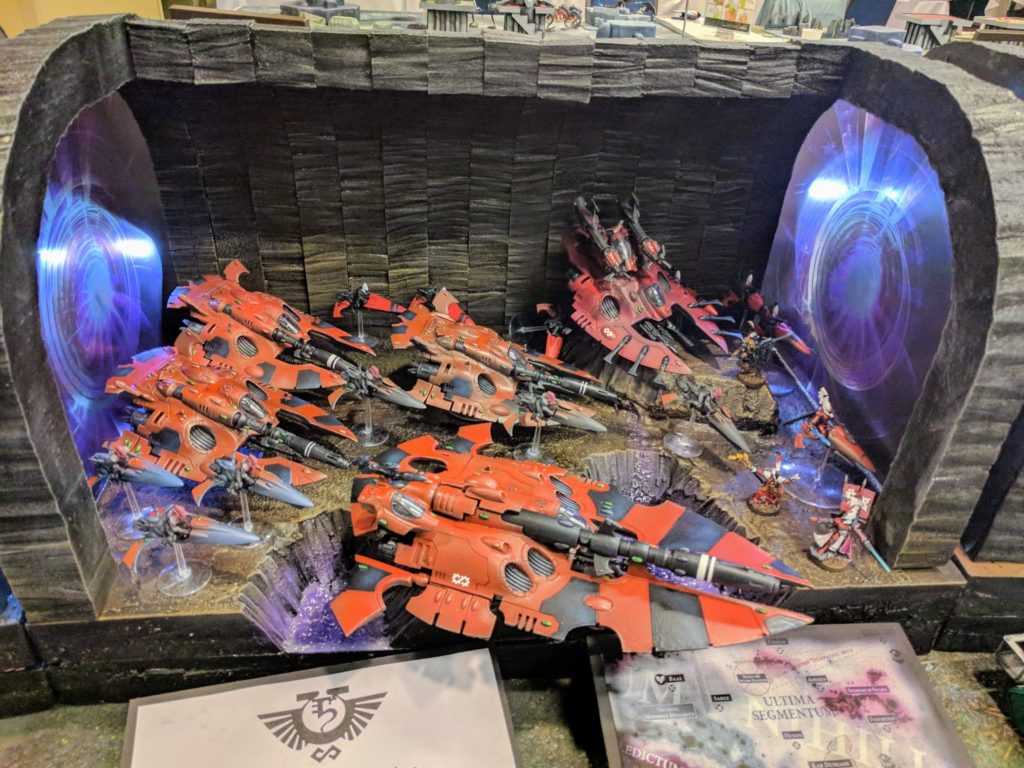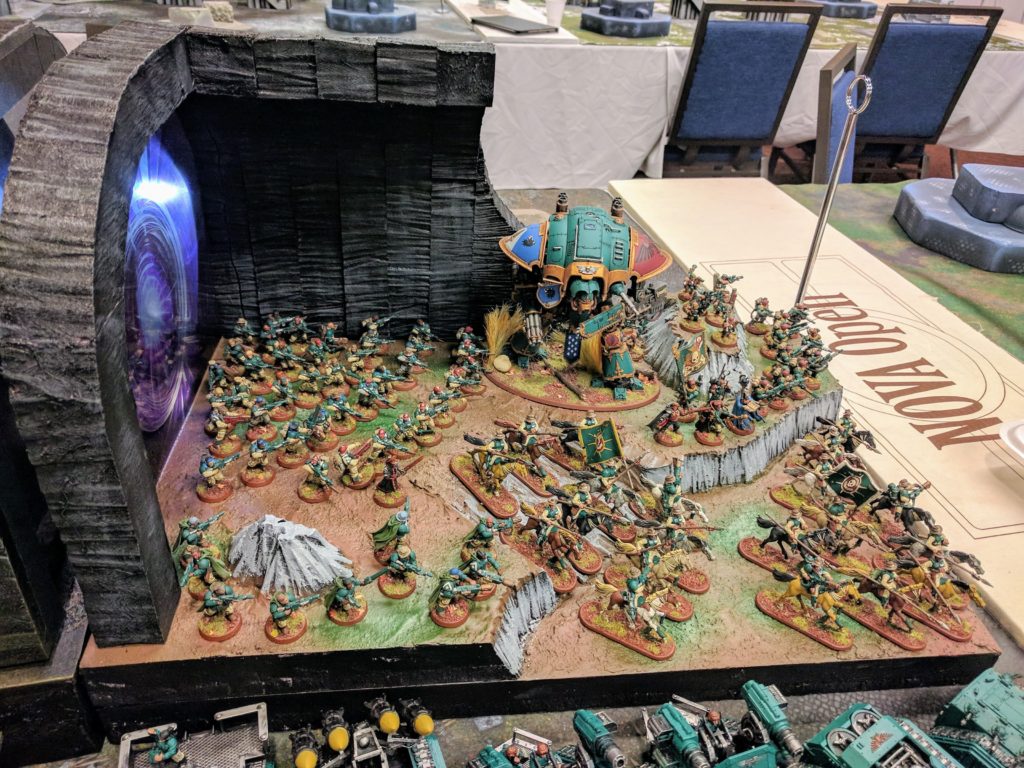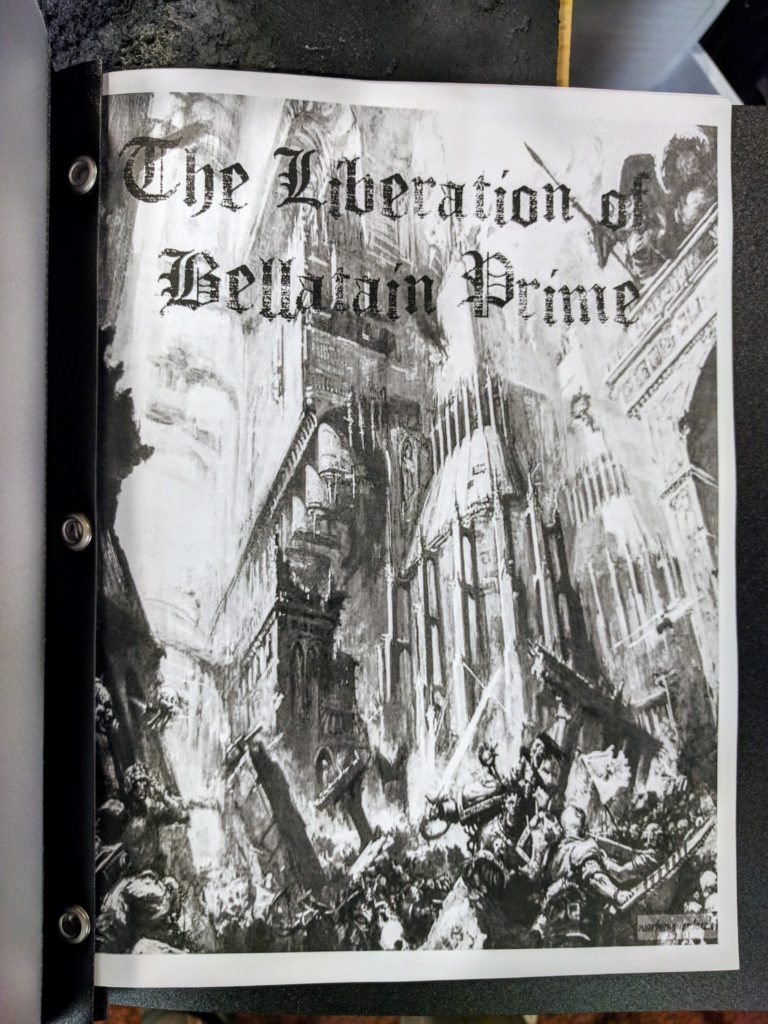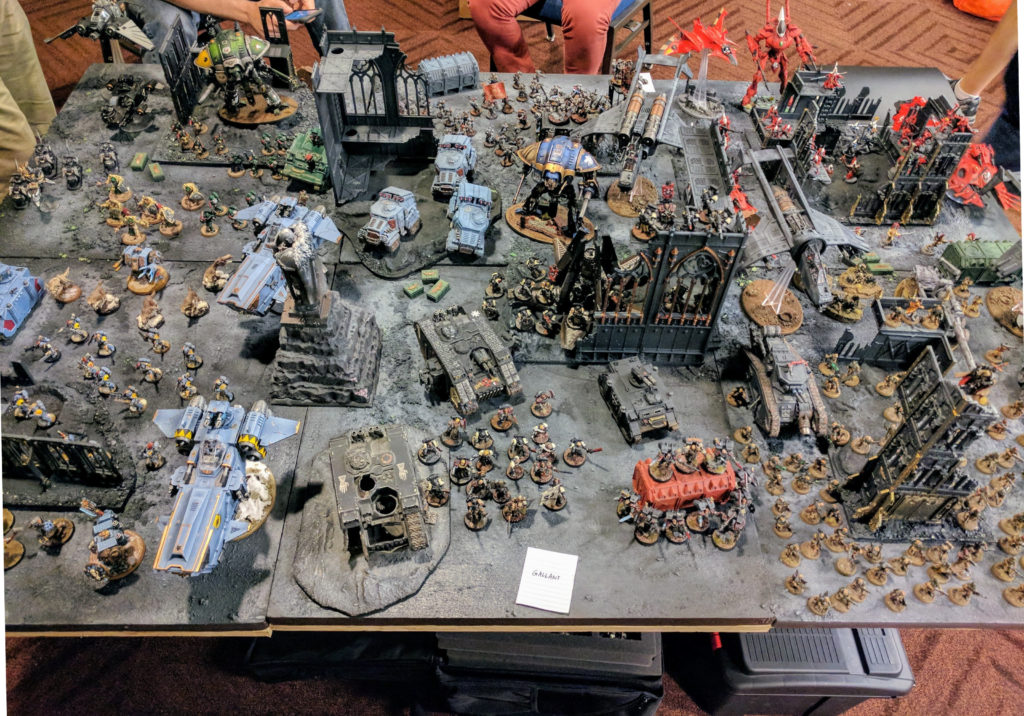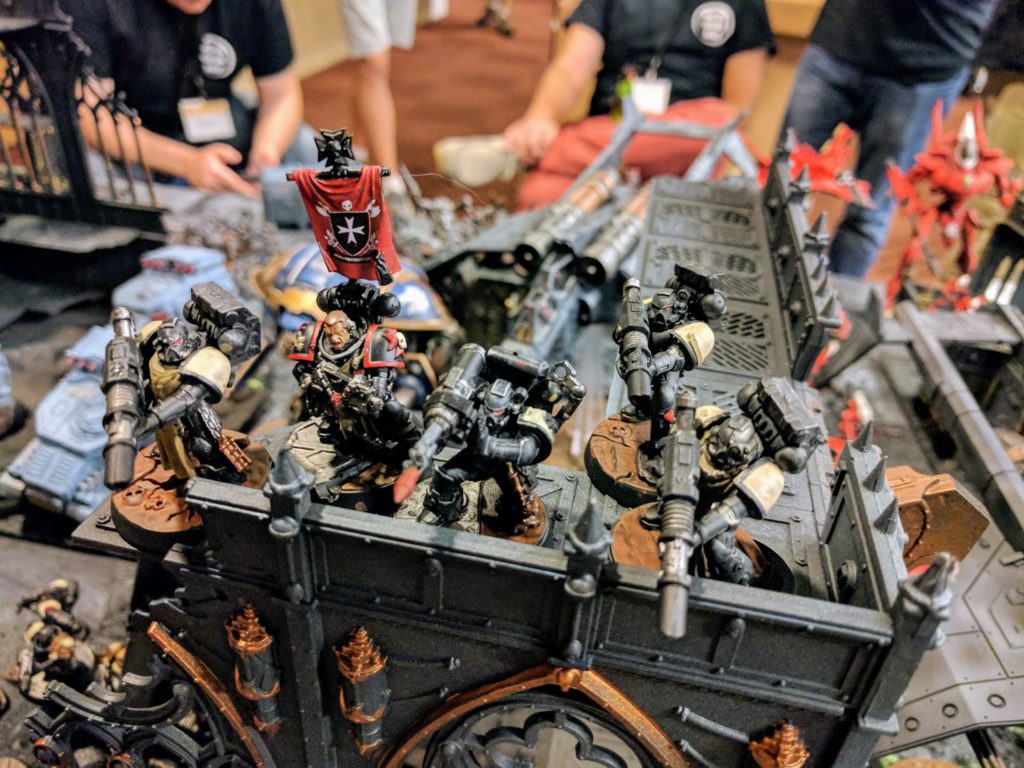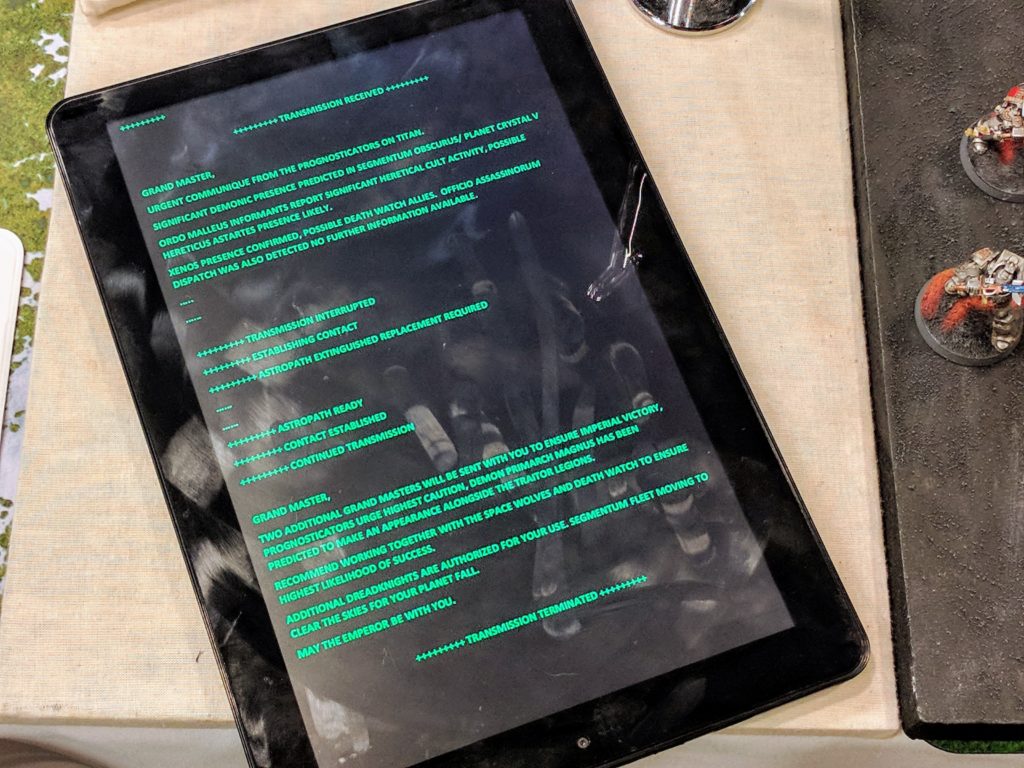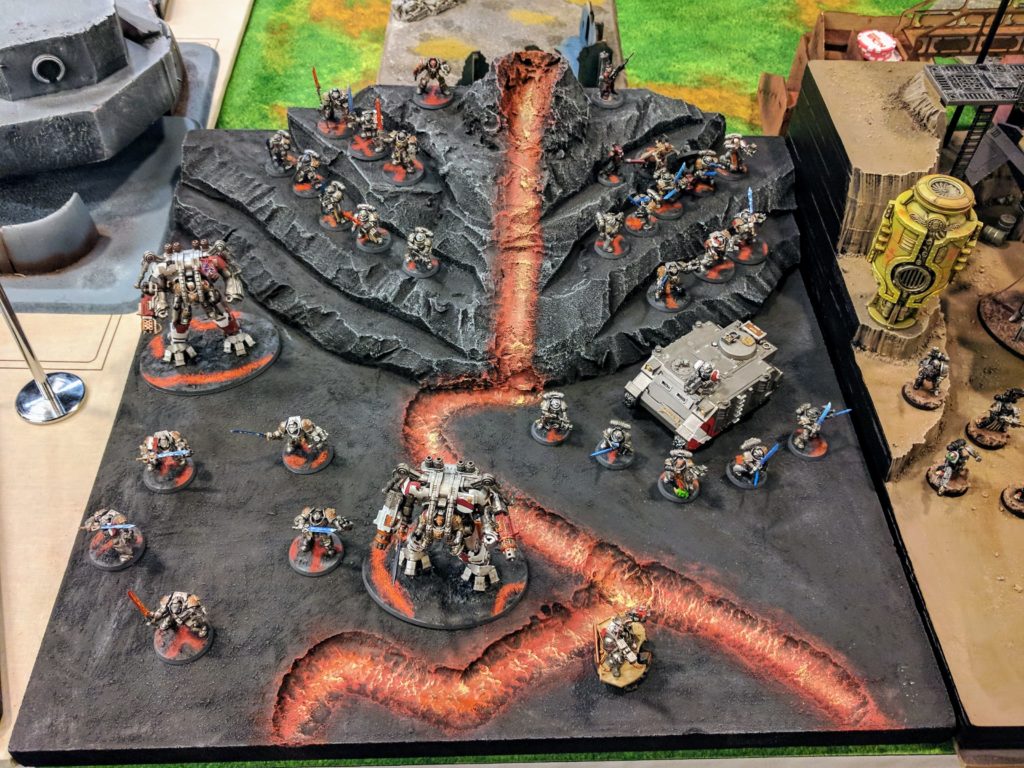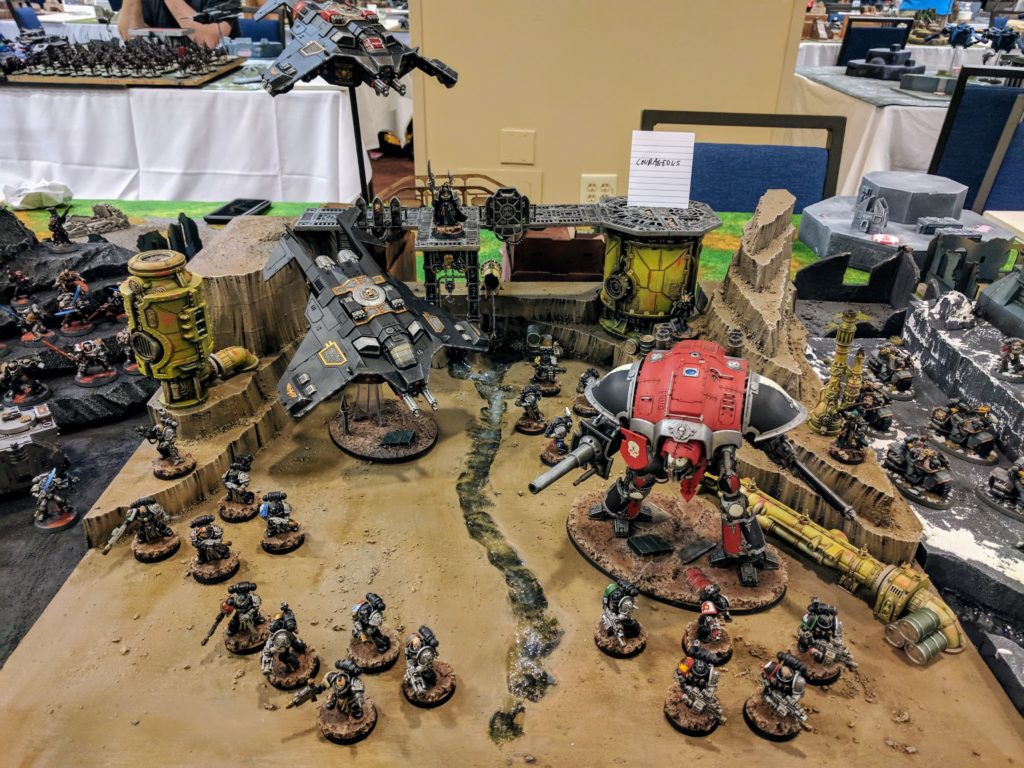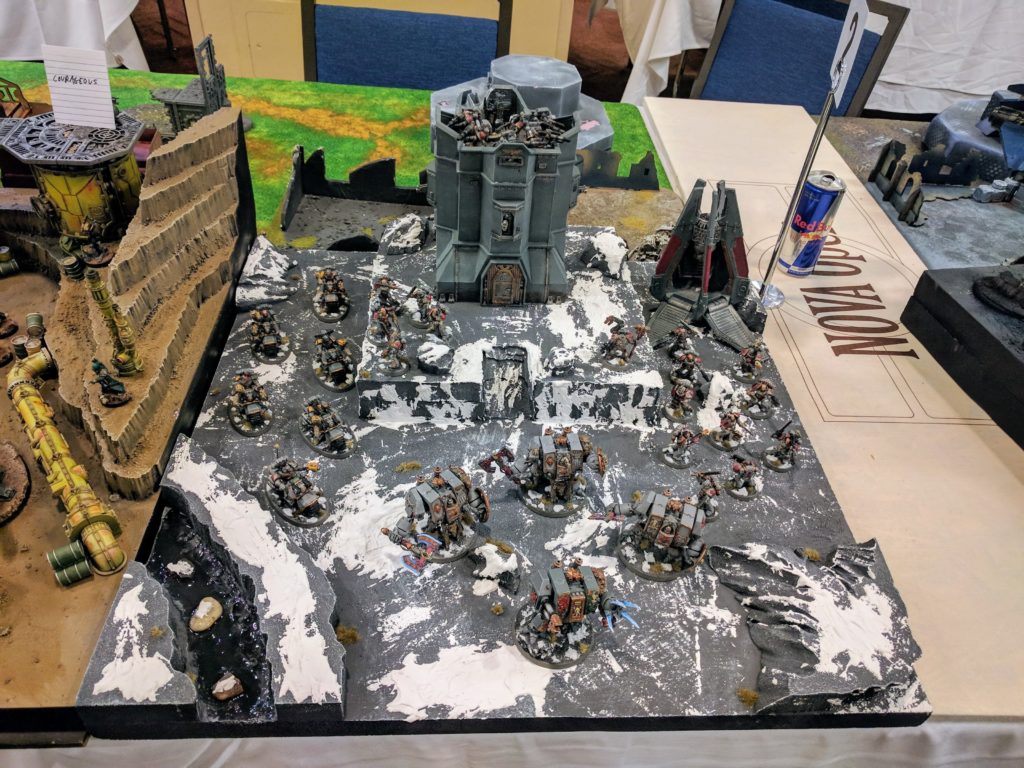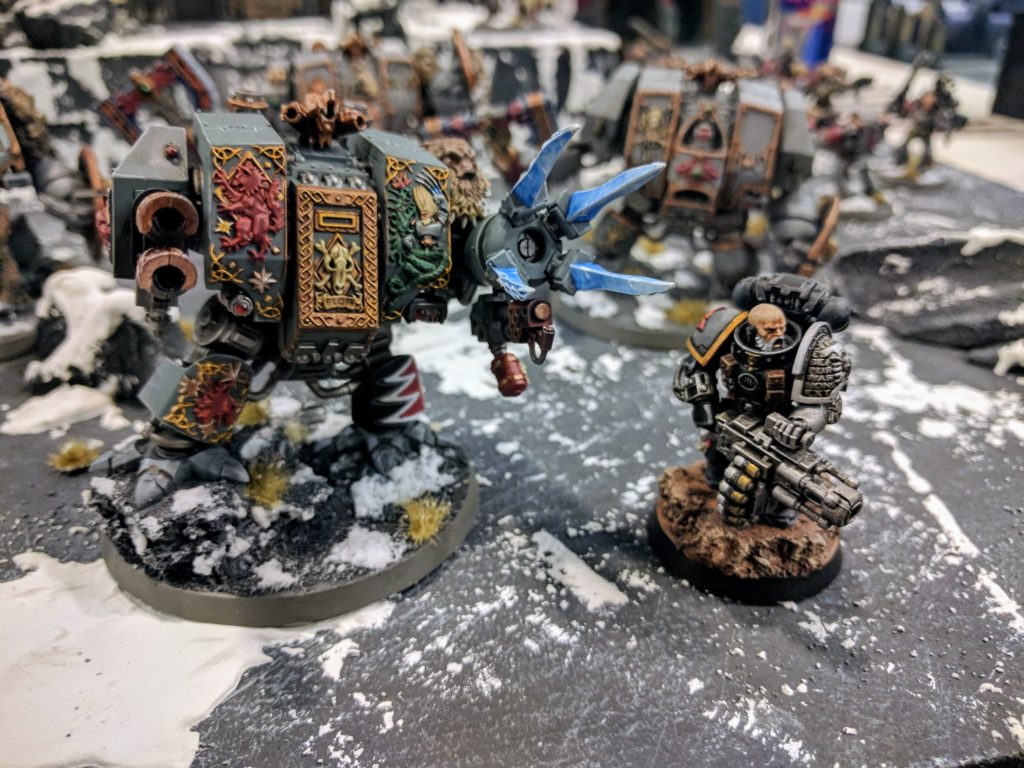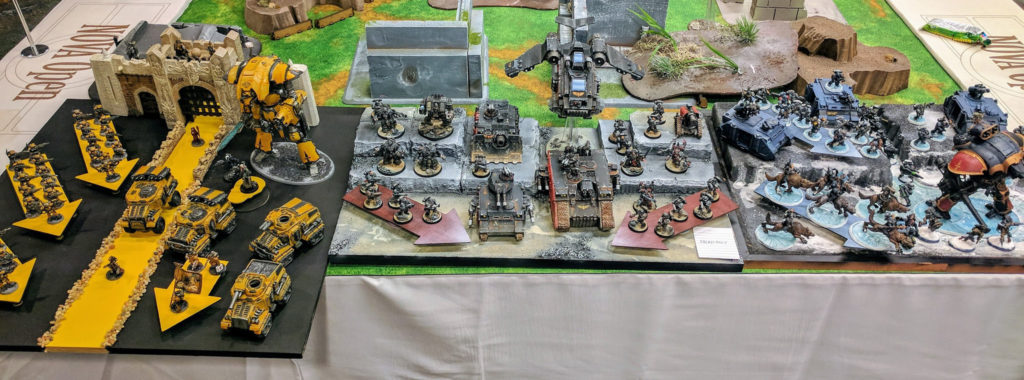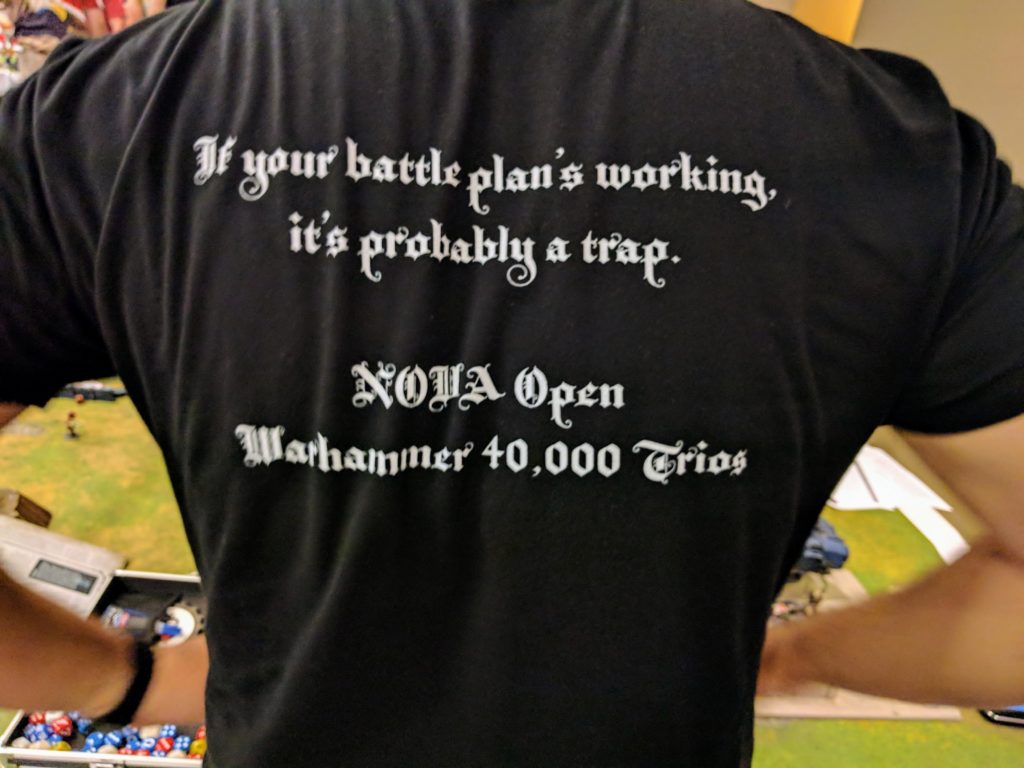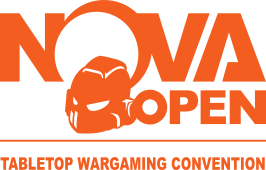 Literally immediately following our 40K Trios Team Tournament, Colin and I again hosted this year’s NOVA 40K Narrative, our third outing as leads.
Literally immediately following our 40K Trios Team Tournament, Colin and I again hosted this year’s NOVA 40K Narrative, our third outing as leads.
A good way to succinctly describe the event is that I made a boardgame which 160+ people then played, with each move and action resolved by playing an entire miniatures wargame. Another is that many dozens of us, with many many more dropping in & out, spent ~4 days leveraging the casino-lit unreality of a convention hall, running games almost continuously from 9pm Thursday to 6pm Sunday, to live in and breathe life to another universe complete with maps, factions, heroes, villains. Though not without its challenges, it was pretty amazing.
All told we had seven rounds of standard 40K (including two doubles rounds), four Kill Team rounds, and one Apocalypse, plus four War Council meetings. Most of the regular rounds had 48 players, with one squeezing in 52. The Kill Team skirmishes had 20–26 players and the Apocalypse featured 30 players. Over 160 unique players participated in the 40k Narrative over the course of the convention this year.
There’s really too much to say about everything that happened, so this post is a very quick recap and an overview of the mechanics, how the campaign worked.
Several collections of photos are available:
- My photos from the 40K Narrative on Flickr and Facebook;
- Greg Hess’ photos include many from the 40K Narrative;
- NOVA’s convention-wide galleries have many photos from the 40K Narrative;
- Terrain gallery for the standard, Kill Team, and Apocalypse battles;
- Some of the armies on display.
There is also a newly formed Facebook group for the 40K Narrative community.
Gateway
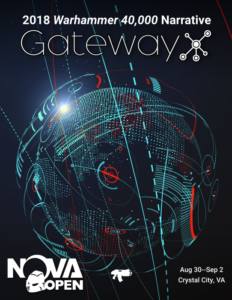 The NOVA 40K Narrative is set in its own fictional universe, originally so that factions could be combined in any fashion as players teamed up and now mostly because that framework has a lot of inertia and attachment among the people who’ve been playing in it for years. There is a recounting of the ongoing story in the event primer. The basic idea though is that the Virtue are an advanced, galaxy-spanning hegemony. Centuries ago, over the course of the first couple NOVA 40K Narratives, the Virtue came to Earth, deemed humans wanting, and wound up destroying the planet. And then again. Humanity though escaped out into the stars. Our story over the past few editions of the NOVA 40K Narrative picks up hundreds of years later, with humanity having regrouped and begun a revolution on the fringe of Virtue space.
The NOVA 40K Narrative is set in its own fictional universe, originally so that factions could be combined in any fashion as players teamed up and now mostly because that framework has a lot of inertia and attachment among the people who’ve been playing in it for years. There is a recounting of the ongoing story in the event primer. The basic idea though is that the Virtue are an advanced, galaxy-spanning hegemony. Centuries ago, over the course of the first couple NOVA 40K Narratives, the Virtue came to Earth, deemed humans wanting, and wound up destroying the planet. And then again. Humanity though escaped out into the stars. Our story over the past few editions of the NOVA 40K Narrative picks up hundreds of years later, with humanity having regrouped and begun a revolution on the fringe of Virtue space.
Two years ago, we played out the beginning stages of that rebellion, with players securing a foothold for humanity in Virtue space from their hiding places on the Fringe. Last year humanity seized Kaipan, a critical bend gate facilitating interstellar travel in and out of their sector of space. This year they tried to exploit that to spread deeper into Virtue space and attack Gateway, the regional governance center.
Suffice to say, humanity as roleplayed by the 40K Narrative players tends to have a very “YOLO!!” take on strategy, confident that the species will be retconned back into existence if they screw up. Hence the multiple burnings of Earth. This year they went for broke to claim Gateway, and they… broke? The early going was promising as they seized the important bend gate facilities at Toman and Pau. Virtue came back strong however, counterattacking into humanity’s base in the Fringe while defending Gateway and pushing back on Toman and Pau. This lead into a final apocalyptic showdown in the Fringe, which humanity defended with gusto but ultimately could not hold.
So, coming out of 2018, humanity retained control of the bend gate facility at Kaipain and gained the industrial world of Folr, but is deeply on the backfoot with the Virtue quickly expunging the rebellion’s forces throughout the Fringe.
Terrain
A big upgrade for this year was that one of our players, Chris Stover, brought literally a trailer full of super high quality terrain. Black Maria Designs also donated several of their Gantry System and Table-in-a-Box sets to NOVA. Victory Gamers and another of our 40K Trios teams also lent their display boards spur of the moment to be tables, and I brought a handful by my friend Matt and I. TABLEWAR also previously donated stacks of F.A.T. Mats to NOVA. All told that meant we had a full slate of gorgeous, thematic, wonderful battlefields on which to play out the 40K Narrative. Photos of the tables specifically can be found in this gallery. Special thanks goes to Chris, bringing in all that terrain was a huge effort, with setup and teardown a full day before and after the convention proper, and it really leveled up the event.
Armies
Matching the terrain, we as usual had an astounding collection of armies in play. Some of them on display are viewable in this gallery. The full effect of looking out over a room full of battles with both beautiful terrain and miniatures can’t be understated, and so many of them greatly rewarded getting in close to really enjoy the details.
Missions & Civilians
The core of the Narrative these past three years has been twofold: Thematic missions, and civilians. We use the same core mission packet here as our LibertyHammer event (June in Philadelphia, join us!). Each of the nine missions is symmetric, so individual players aren’t put at a disadvantage in their games as the alliances attack or defend, but six are themed and have some interesting mechanics. Shuttles crash and pilots have to be captured/rescued; comms facilities have to be taken or destroyed; supply depots and refineries raided; convoys ambushed or escorted; and VIPs protected or assassinated. Each round, half the players get to play a mission of their choosing.
In addition, the 40K Narrative does not happen in a vacuum. Civilians are present in each match which players can either save or slaughter. They’re Neutral NPCs which players can either attach to their units to escort them back to their deployment zones, or attack as though any other enemy unit. Doing so gains players’ armies Fame or Infamy as they build a reputation for savagery or heroism throughout the campaign. Many players focus a lot more on these than they do on winning games, which is perfectly valid, and leads to a lot of roleplaying and interesting dynamics.
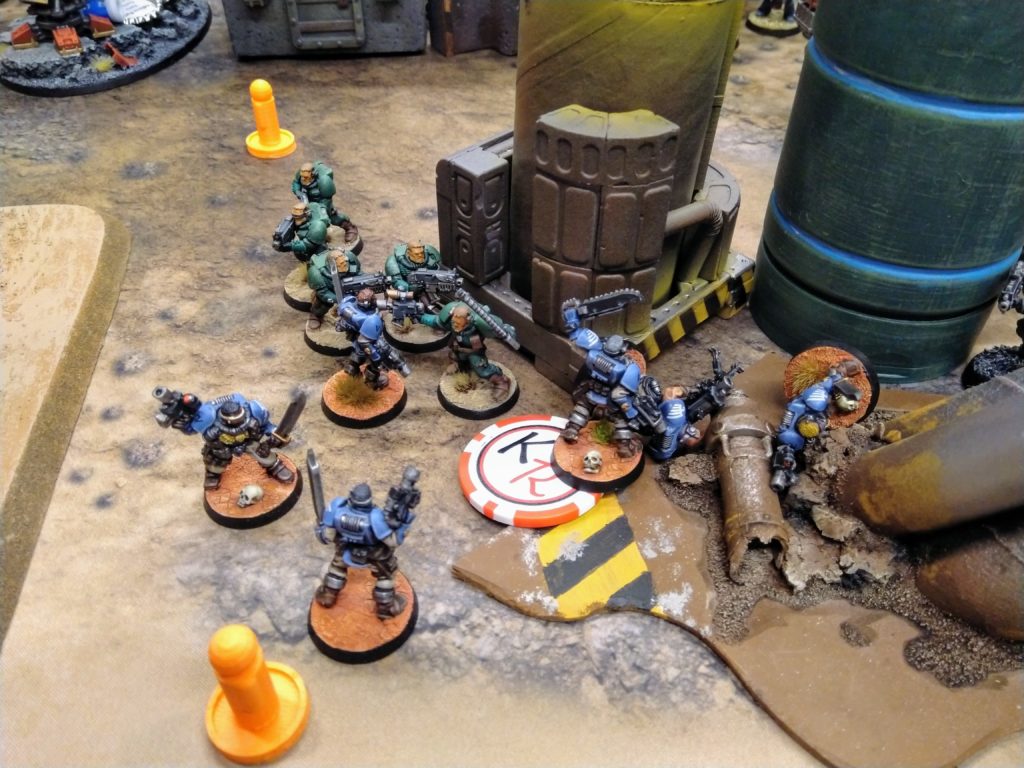
Opposing bands of Scouts clash hand-to-hand in an industrial facility as one tries to also protect a civilian.
Campaign Mechanics
On top of those core elements is built the campaign. Key to that are the Warlords, players who’ve registered for one of sixteen slots to make strategic decisions for the Humanity or Virtue alliances. In large part to manage our increasing number of players, this year the Warlords divided up into pairs leading four campaign groups on each side, to which other players were assigned and fought together throughout the convention.
This year we also campaigned over the explicit map above, adapting mechanics from the ~6 month Solypsus-9 campaign I ran in Philly several years ago. At their twice-daily War Councils, the Warlords chose attacks on that map which were then played out in the games. The mechanics are simple:
- Each alliance starts out in control of some subset of locations based on last year (i.e., the humans controlled Kaipan from their victory last year, while no one controlled Satakad, reflecting the continuing unrest on the edge planets).
- At each War Council, both alliances get six order tokens, two each of Attack, Defend, and Support.
- The alliances simultaneously place four orders facedown on the map. They must place their two Attacks, and have a choice to Defend or Support or both with their other two orders. Orders are placed on locations controlled by the alliance, and multiple orders may be placed on any one location.
- Orders are then revealed and the alliances alternate in initiative order choosing an Attack of theirs and designating an adjacent map target and a campaign group to make the attack. The opposing alliance responds with a defending campaign group and a theater—Fear, Blood, Hope, or Death, one of our four rows of primary tables. Each matched campaign group then paired individual players (or doubles teams in some rounds), alternating between one side putting forward a player and a mission and the other responding with a player and a table within their theater.
- The battle for each map location is then resolved per round with some straightforward calculations:
- The battle points from each game in a location under Attack are summed.
- Defend tokens add +7 to the campaign results (not individual games) for each match in the designated location.
- Support tokens add +3 to the campaign results for each match in the designated location and each adjacent location.
- The alliance with higher sum in each location wins the round there.
- Instead of accumulating direct scores though, to help prevent runaway leads, winning a round for a location awarded the current round number.
The specific numbers here (two Attacks, four theaters, etc.) are derived from our particular configuration at NOVA—two factions, four campaign groups, and so on. More generalized mechanics are in the original Solypsus-9 writeup, supporting two or three factions and a variable number of actors (either players directly as there, or campaign groups as in NOVA’s much larger event). The key though is permitting a lot of flexibility for players to come in and out; avoiding players or groups either repeatedly fighting the same opponents, as happens in many map campaigns, or being pushed off the map entirely; and keeping the campaign simple & understandable while also creating an additional layer of strategy. Striking that latter balance is critical as there is already so much going on in 40k, the campaign, and the convention as a whole, but connecting the games all together is of course a huge draw for the event.
Assets & Advantages
In addition, each round the Warlords chose Recon Squad missions for their campaign groups. These were played out as Kill Team games, mostly by other players just joining the 40K Narrative over lunch or dinner for quick skirmishes. Each mission in the Kill Team mission packet that Games Workshop put together for NOVA was associated with a particular benefit. By winning games, Recon Squad players claimed cards for those benefits that Warlords gave out within their campaign groups to assist their players.
Several other Assets & Advantages were also dungeon-mastered into the event as it ran. For example, to help deal with there being too many Imperial Knights around, we threw in a Saboteurs card that let players use Civilians to deal mortal wounds to vehicles trying to escort them. Several players also got cards for being helpful, like ordering a megaphone to be delivered mid-round so I stopped tearing my vocal chords.
Characters
In part because the traditional stratagems have less meaning, or are at least more difficult to make interesting without stepping on any particular faction’s unique advantage, now that the core game itself has so many, this year we also introduced several special characters. These drew from the past several years of storyline, the little bits of fluff here and there in the event primers. So, for example, the 2016 primer had a prominent quote from Premiere Thyx, who finally made an in-game appearance.
Apocalypse
Finally, the last round of the campaign is a giant Apocalypse, with everybody fighting all at once for a particular battle. The specific setup for this gets dungeon-mastered a good bit. Last year we made this the battle for the six gravitic generators on Kaipan. This year, following the evolution of the map over the weekend, it was quite naturally humanity’s last stand at one of their bases in the Fringe.
We’ve been running one or more major (~20+ players) Apocalypse battles annually for six years now, so we have a well established and tested set of rules, procedures, and mission archetypes. For this year’s NOVA 40K Narrative finale we had thirty players fielding a total of 91,000 points, all fighting over a 6×24 table. Four primary objectives were placed by us, secondary objectives by each player, and the alliances given L-shaped deployment zones. Our rules and table layouts help ensure these aren’t just shoot-outs among the biggest units, with much of the game coming down to individual troop movements. This match ended exactly on time, running from 10am to 5pm sharp, with Virtue edging out Humanity in the final rounds for a 160–112 win.
Crew
At this point, the NOVA 40K Narrative is somewhat overwhelming. Suffice to say, probably not too many TOs’ kits include a sleeping bag and a laminating machine. Fortunately we’re building a good crew as we go to keep the campaign running smoothly even as it gets bigger and more complex. Colin oversees all the table and round management, keeping games going and ending on time, on top of a bunch of other tasks. Chris has taken on ensuring we have tons of amazing terrain. Dan, Scott, and Katie work people marshaling and rules development. Greg and Todd do appearance judging. Many people help out. And, of course, the Warlords are now executing much of the campaign mechanics and pairings themselves. We’re already working on designating and delegating more roles for the coming year, so I’m optimistic about both the continued excellence and the sustainability of the event.
Narrative
Sometimes people ask what “narrative” wargaming means. I’ve had some thoughts over the years. To a lot of people it means playing for fun, rather than competitively, and throwing in a bunch of goofy elements—unusual terrain, environments, stratagems, characters, weird missions, whatever. It is all those things, but I emphasize doing so in service of crafting a story. We try to keep the mechanics somewhat light in the NOVA 40K Narrative, but add just enough to enable meaningful roleplaying and storytelling in a multi-game and even multi-year context. Although simple, our maps and other mechanics present real strategic decisions and create just enough opportunities for participants to make decisions toward their chosen characters. That might be an individual focused on gaining Infamy for their butcherous army, or a group roleplaying collectively, such as Humanity’s continued commitment to just going for it and damn their home base. At several points this year the human alliance knew what the smart campaign decision was and instead played to that reckless character it’s developed over years of play now among this community. That’s what we hope to enable, and it’s great to watch.
Next Year
For 2019 we’ll probably make some notable changes, but all in keeping with the basic approach and tone of the event that has worked so well the past three years.
I expect the core mission set to remain similar, but tweaked to freshen it up. If civilians stick around they’ll likely switch to 8th edition Characters rather than using 7e-style rules, which was discussed at length for this year but not implemented.
Also very likely is essentially dropping individual scoring. Games will obviously be scored to determine who wins and by how much, in order to advance the campaign if nothing else, but we just won’t track individual standings. It’s also possible that Fame and Infamy will either use different mechanisms or also be unscored. There’s some ongoing discussion about awarding titles in completely different ways, e.g., accumulating points from some kind of voting for most dramatic or thematic play each round, but this is all very up in the air. The goal is just to continue tweaking the formal rules to match what we all want to get out of the event. All our participants are already pretty low key about results, and these kinds of changes would just further emphasize that it’s a campaign and a collaborative narrative, not a tournament.
Other, sometimes mutually exclusive, idea fragments include:
- Rebooting to a story in the 40k universe, possibly with the same alliance labels;
- Removing a round from each day to make the schedule more relaxed;
- Collecting the Recon Squad rounds into a single multi-round time slot;
- Having more briefings and executing them a bit more formally, so players beyond the Warlords can more readily follow the developing campaign;
- More prominent army display & judging, possibly as a social gathering;
- Expanding to more tables if possible, probably the case for at least Nightfights.
Long story short, the only thing we’re totally sure of is that next year will be another great event. Comments and ideas on all these topics are extremely welcome (in comments below, on the NOVA survey, or please feel free to email).
![]() One small step we’ve already taken for next year is to create a NOVA 40K Narrative Facebook group. We hope this will become a fun community forum to display projects from this year, share progress on projects for next year, and coordinate. Please join us!
One small step we’ve already taken for next year is to create a NOVA 40K Narrative Facebook group. We hope this will become a fun community forum to display projects from this year, share progress on projects for next year, and coordinate. Please join us!
Wrap Up
Another year of the NOVA 40K Narrative in the books! We thought it was great, and hope you enjoyed it as well. If you like this kind of gaming and are anywhere near Philadelphia, you should check out our other events, either on the Web or Facebook.
Again, there are several collections of photos available from this year:
- My photos from the 40K Narrative on Flickr and Facebook;
- Greg Hess’ photos include many from the 40K Narrative;
- NOVA’s convention-wide galleries have many photos from the 40K Narrative;
- Terrain gallery for the standard, Kill Team, and Apocalypse battles;
- Some of the armies on display.
And don’t forget the new Facebook group.
See you next year!
